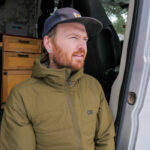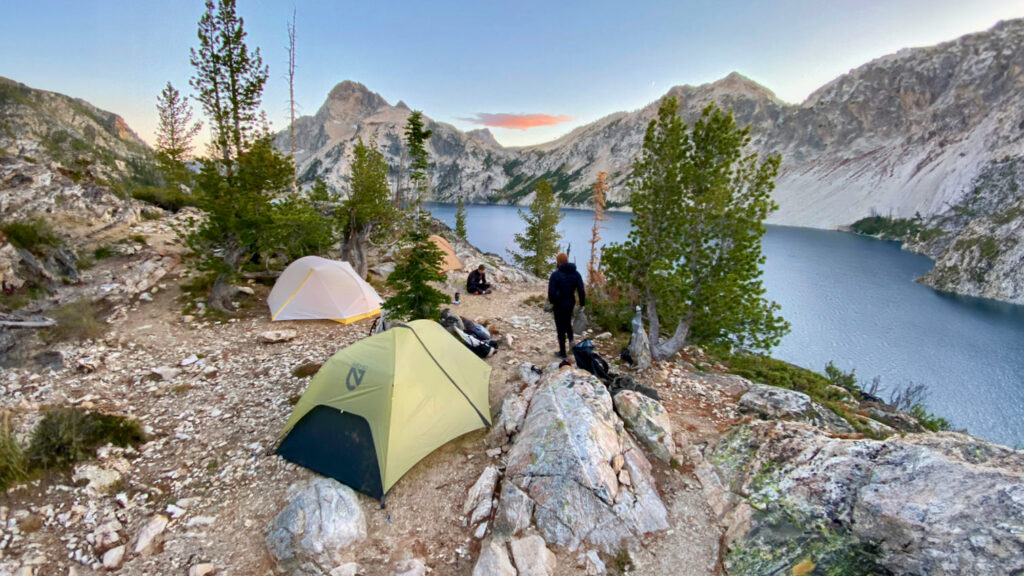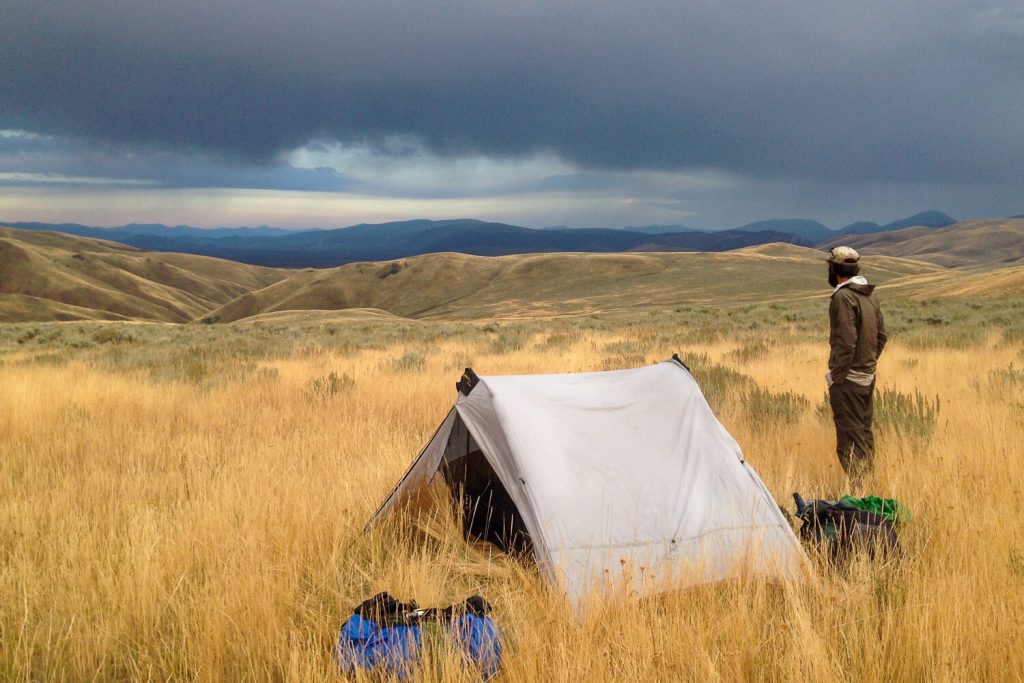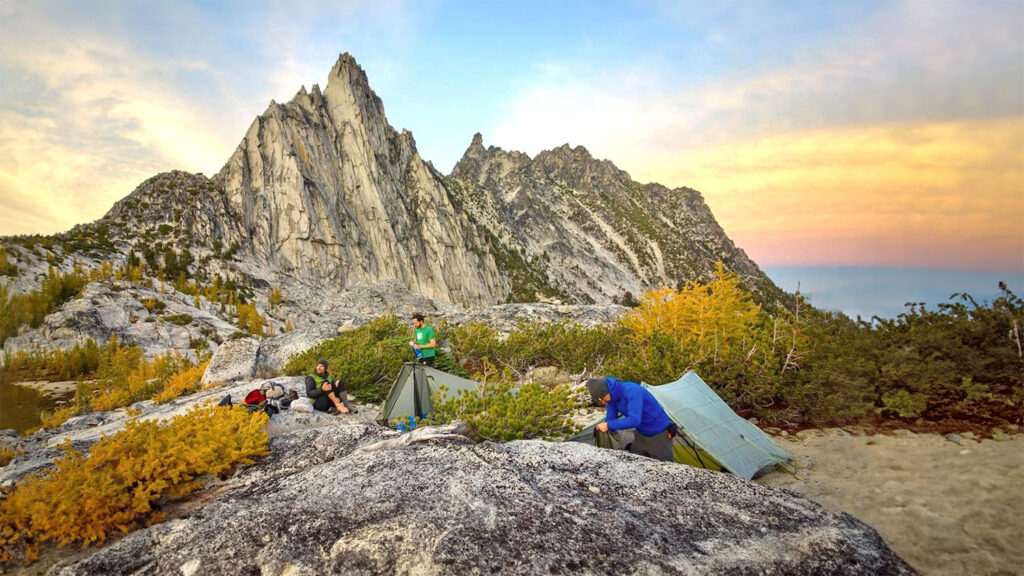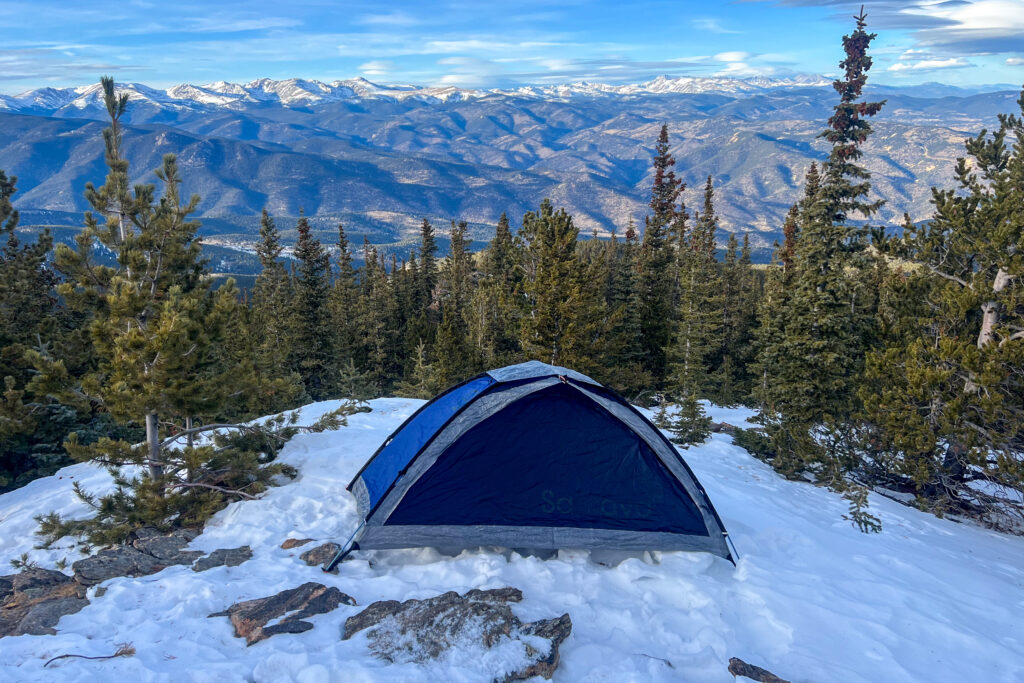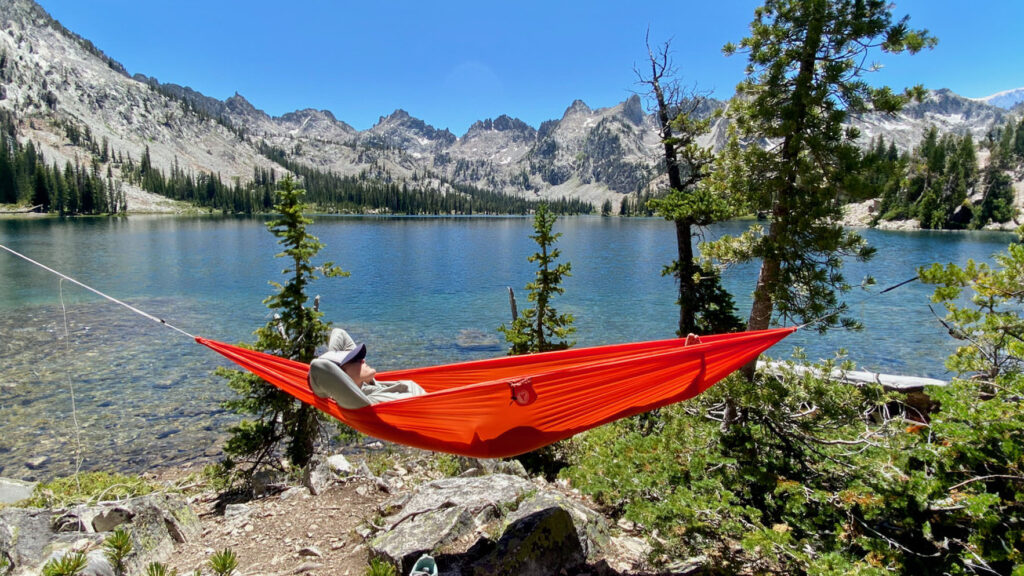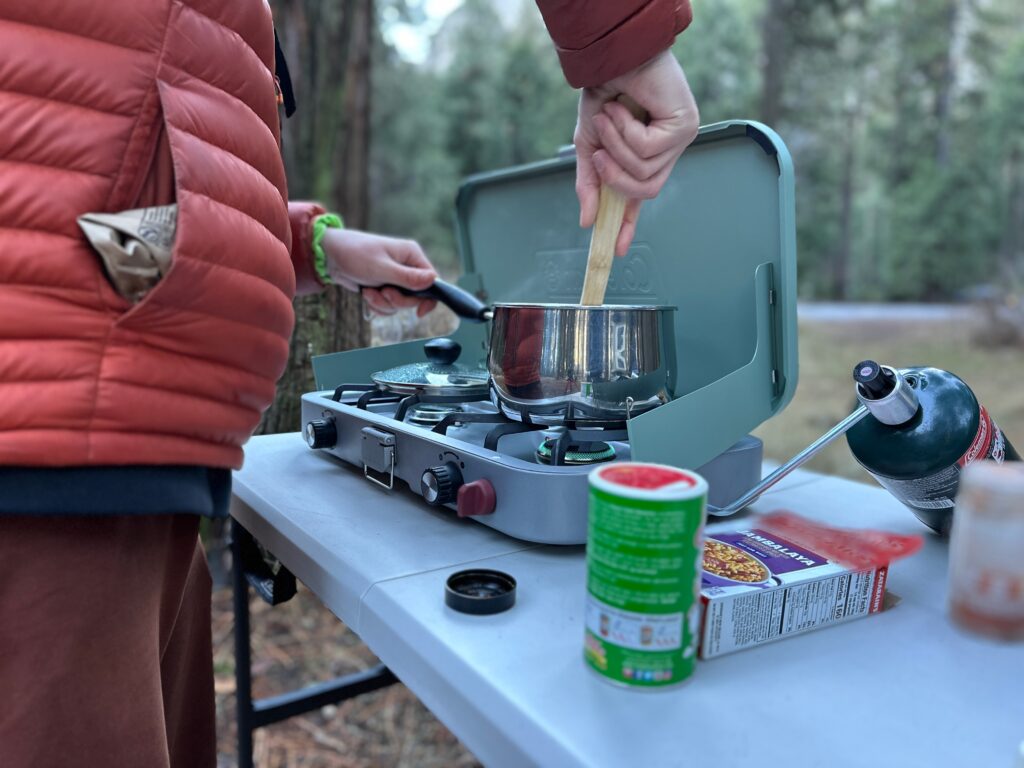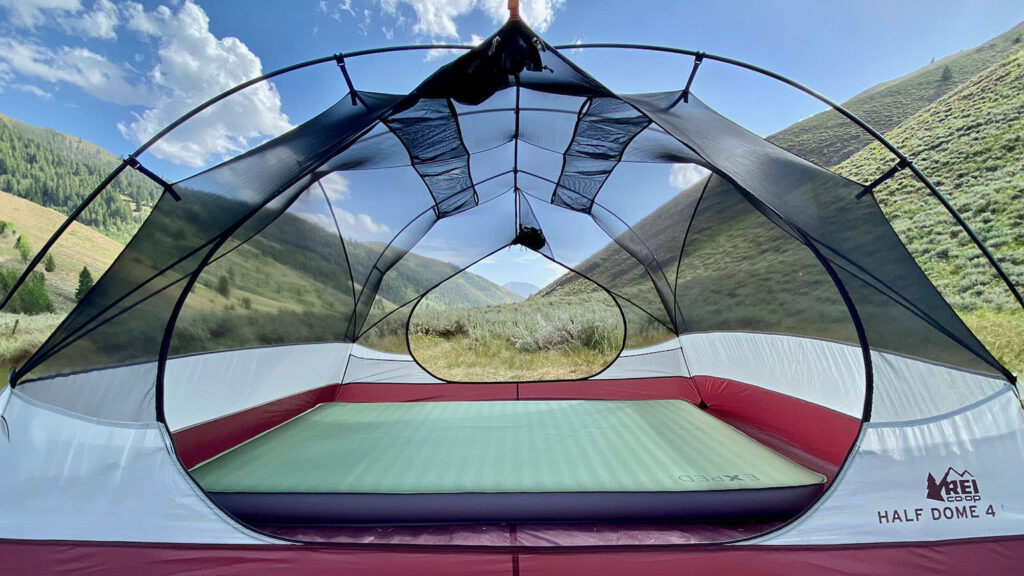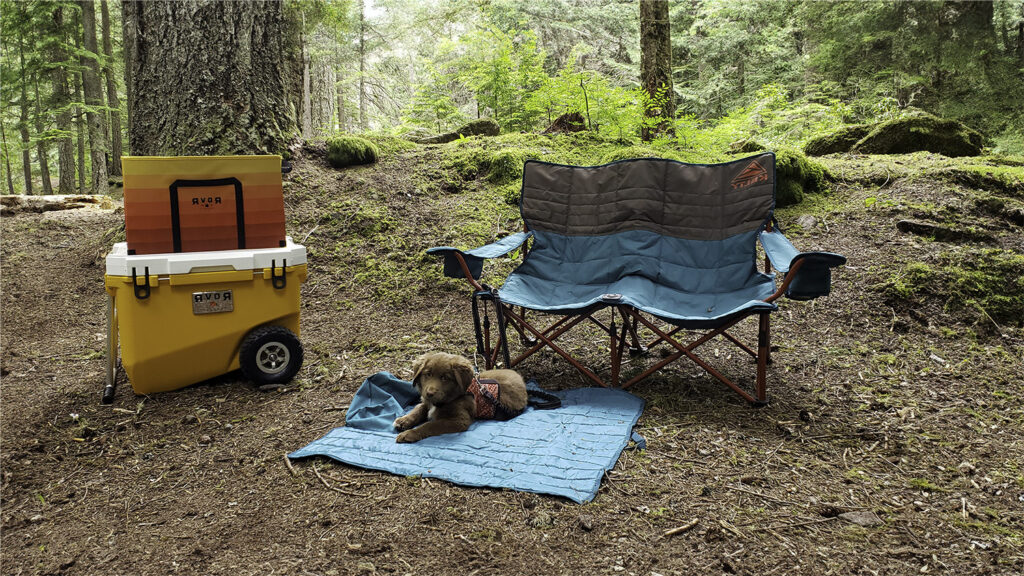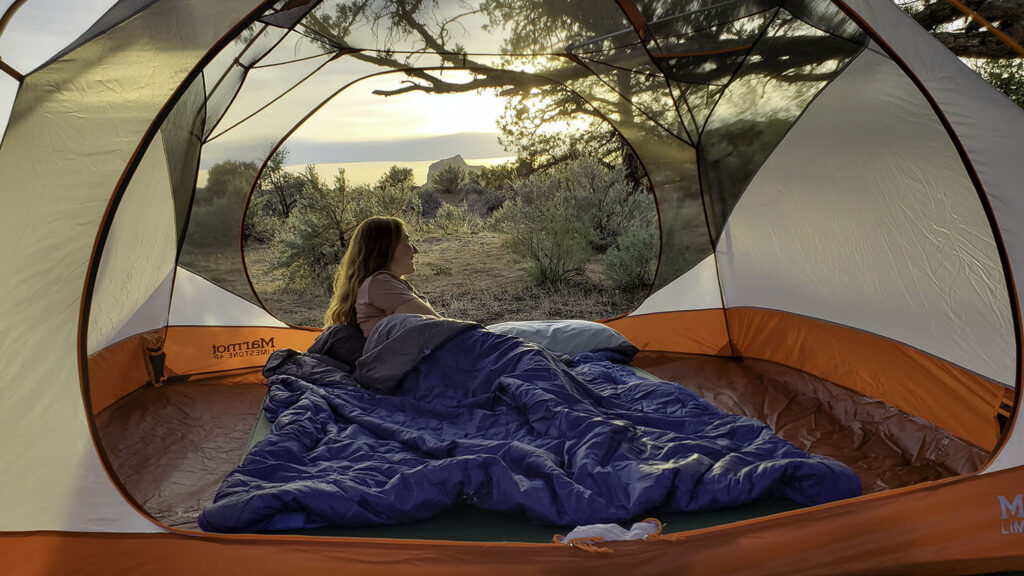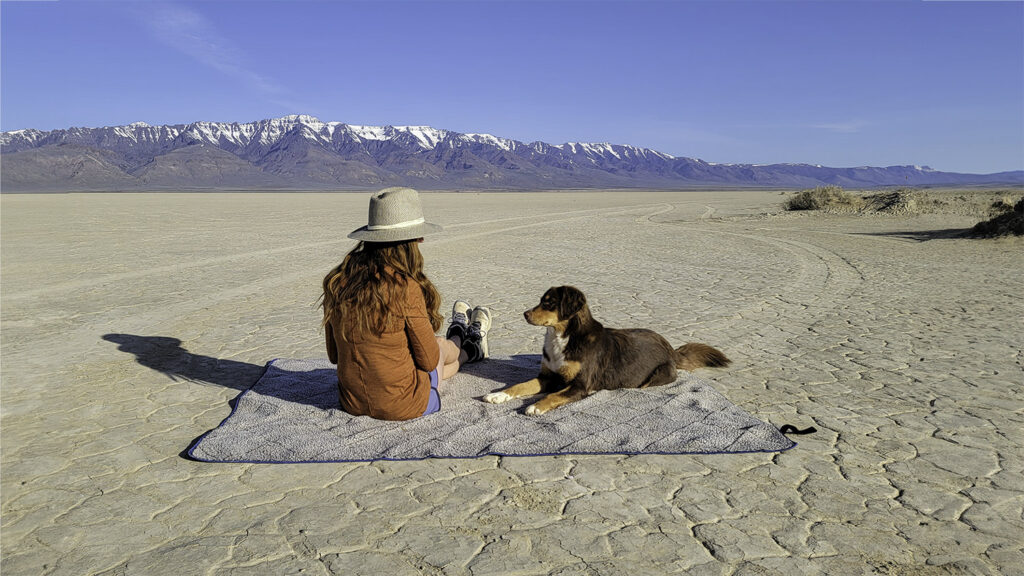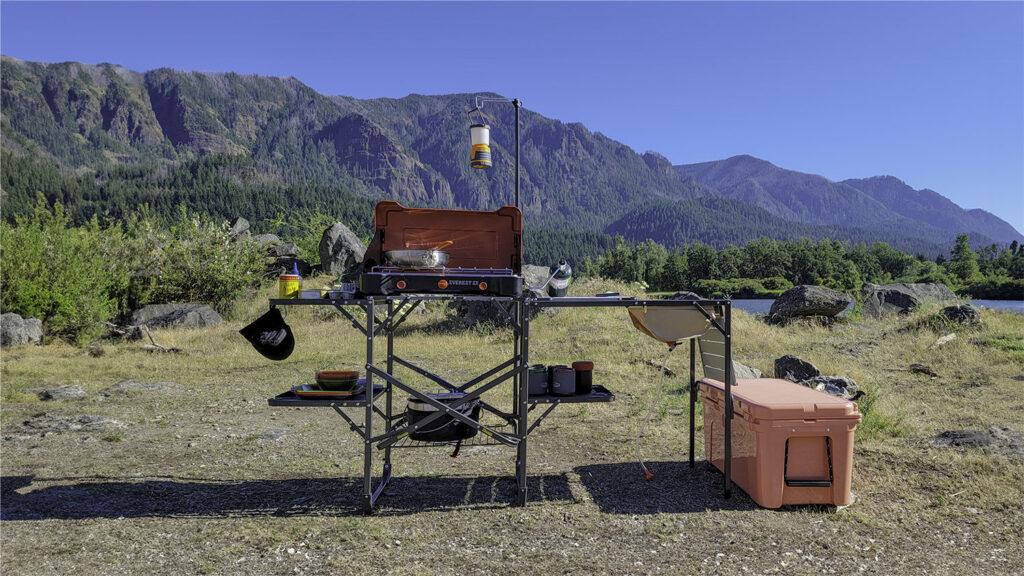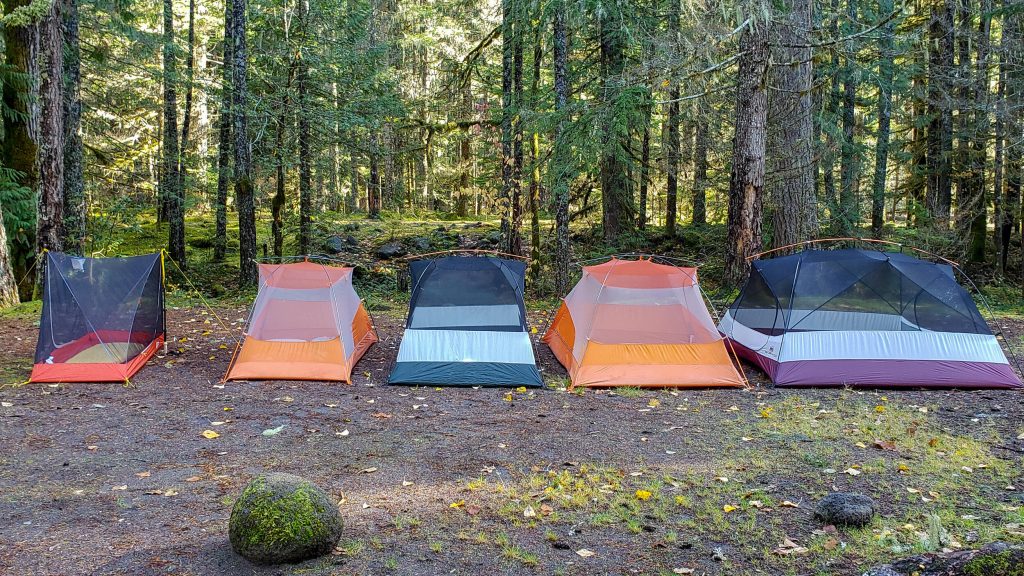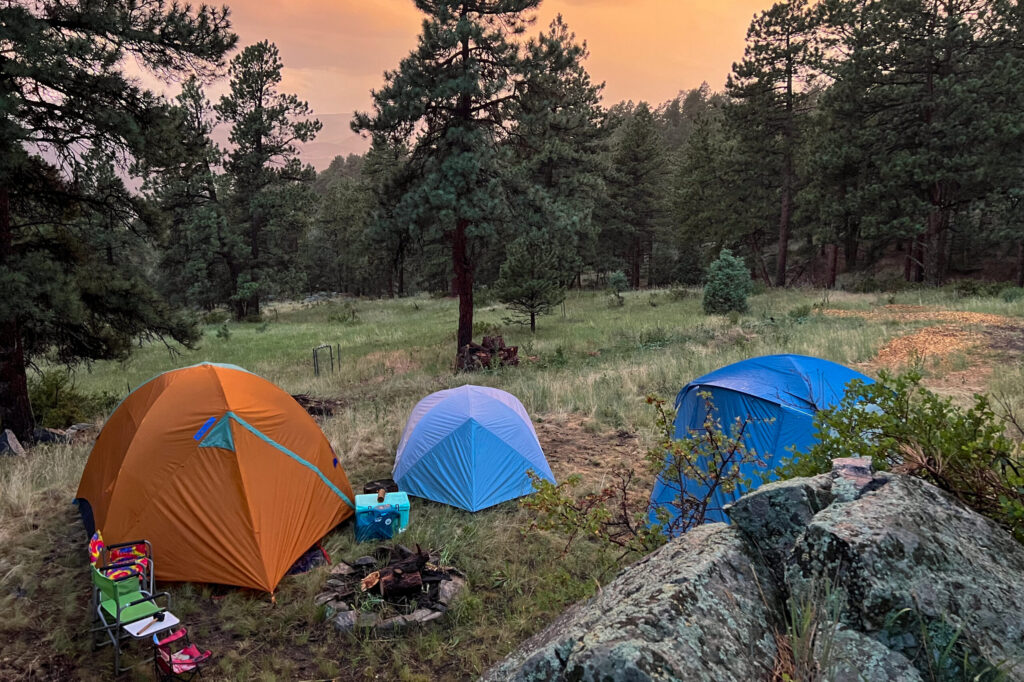
We’re here to help you find the perfect camping tent for your next frontcountry adventure with your favorite people – and pets.
Our team of professional gear experts has spent countless hours researching and testing over 50 camping tents from NEMO, REI, Marmot, The North Face, and more. We’ve spent dozens of nights car camping to narrow our list down to the most promising models. Based on our hands-on testing, we’re confident you’ll find a tent here that’s a great fit for you: comfortable, durable, weather-resistant, easy to set up, and feature-forward.
And for more info, check out some of our other most popular gear guides:
Quick Picks for Camping Tents
Check out this quick list of our favorite camping tents, or continue scrolling to see our full list with in-depth reviews.
Best Camping Tent Overall: NEMO Aurora Highrise 4 ($400)
Best Luxury Camping Tent: REI Wonderland 4 ($499)
Best Bang for Your Buck: Kelty Wireless 6 ($280)
Best Crossover Choice for Camping & Backpacking: REI Half Dome SL 3+ ($399)
Best Low-Profile, High-Volume Camping Tent: Marmot Tungsten 4 ($399)
Sturdy & Comfortable Tent with a Large Vestibule: The North Face Wawona 6 ($500)
High-Quality & Durable Camping Tent for Two: Mountain Hardwear Mineral King 3 ($375)
Best Premium Camping Tent for Families & Groups: MSR Habitude 6 ($700)
Budget Camping Tent with a Partial Rainfly: Coleman Sundome 4 ($100)
What’s new
Our team of gear testers spent night after night in the woods testing out these new tents and pitting them against our trusted favorites:
- The Mountain Hardwear Mineral King 3 is a top contender for its durable build, huge doors, and excellent ventilation.
- The Kelty Wireless 6 earns a spot as a cost-effective, colorful, and spacious tent that’s easy to use and fast to pitch.
- The Marmot Tungsten 4 makes its way onto the list for its low profile, simple design, and relatively low weight.
Camping Tents Overall Testing Scores
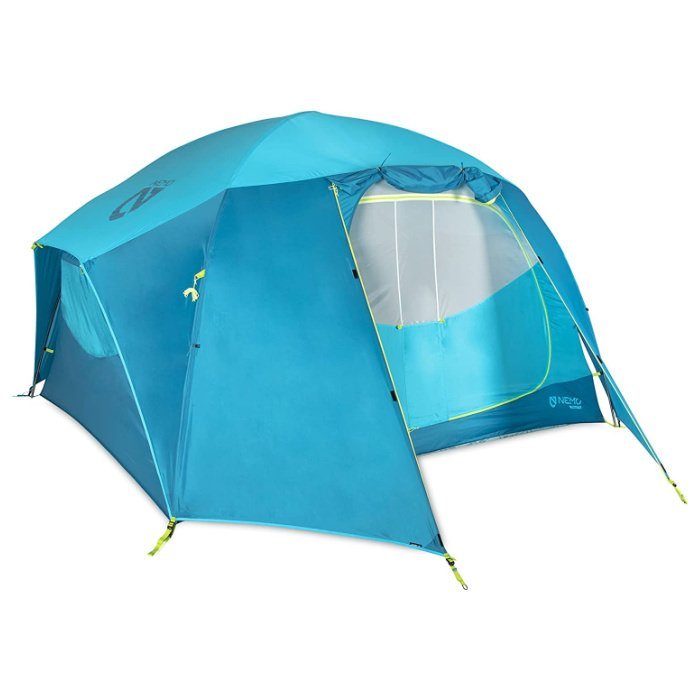
NEMO Aurora Highrise 4
Best Camping Tent Overall
CleverHiker Rating: 85/100
Price: $400
The size we tested feels: Luxurious for 2, comfortable for 3 & tight for 4
Weight: 15 lb. 14 oz.
Dimensions (LxWxH): 100 x 90 x 75 in.
Pros
- High-quality poles & materials
- Two enormous doors with stuff pockets
- Fast & easy setup
- Large livable space
- Excellent ventilation
- Durable construction
- Relatively compact when collapsed
Cons
- Only half door in the back
- Carrying case is tight
The NEMO Aurora Highrise 4 continues to impress us because of its durable build, huge interior space, and versatile design. For couples or families looking for a camping shelter that’s both spacious and easy to set up, look no further than the Highrise 4.
We love the giant door on the front, and that it stuffs away into a small, non-intrusive pocket. While the rear door is quite a bit smaller, we’ve found it doubles as an extra-large vent to keep air moving.
The sturdy white mesh of the Highrise also sets it apart. It allows you to see out of the windows on all four sides, even when it’s raining but still offers remarkable privacy.
The pole structure of the Highrise is unusual compared to other tents this size, so there’s a bit of a learning curve the first couple of times you set it up but it’s a snap to pitch after that. The walls are steeply inclined, so you can stretch as wide and tall as you want in the morning and not touch the ceiling. And it’s plenty durable, so it’ll last for many years if you treat it with care.
Our main complaint about the Highrise is the carrying case – we like when a tent is easy to store once it’s rolled up, but the Highrise comes with a smaller stuff sack, and takes some extra work to fit everything in. The Highrise also doesn’t include a footprint.
That said, this model offers an outstanding value considering its comfort, size, and durability. You can get the 6-Person option for the same price as the smaller version of comparable tents, so we think it’s an excellent value.
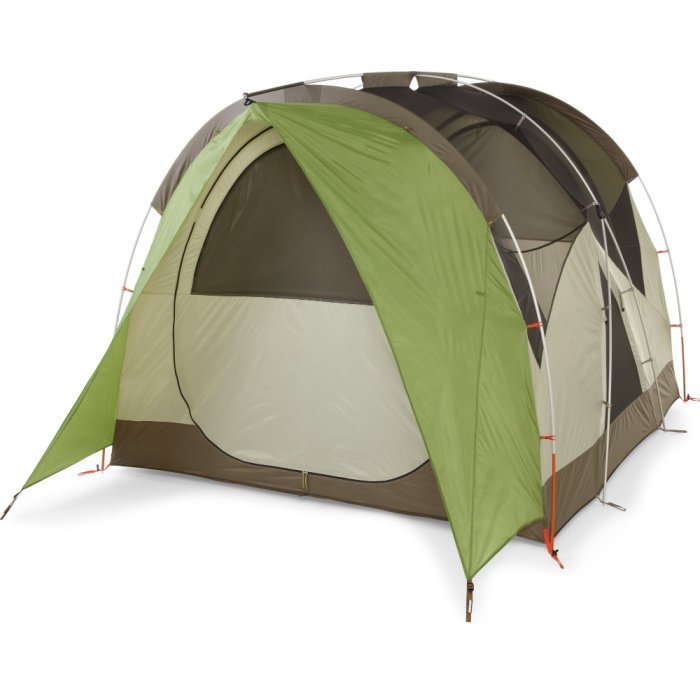
REI Wonderland 4
Best Luxury Camping Tent
CleverHiker Rating: 83.5/100
Price: $429
The size we tested feels: Luxurious for 2, comfortable for 3 & tight for 4
Weight: 21 lb. 11 oz.
Dimensions (LxWxH): 120 x 100 x 75 in.
Pros
- Room to stand
- High-quality poles & materials
- 2 large doors
- Color-coded tabs for easy setup
- Tons of pockets
- Large vestibule
- Smart vent locations reduce condensation
- Awnings over doors
Cons
- Expensive
- Heavy
- Footprint sold separately
- Not as sturdy as others in strong wind
“Luxury” and “camping” are two words we rarely put together, but the REI Wonderland 4 bridges the gap. It’s our pick for the best luxury tent because of its cavernous interior, giant doors at both ends and a generous number of storage pockets to keep your tent feeling organized and tidy.
The Wonderland boasts a distinctive pole design, creating a spacious rounded tunnel shape that makes the tent feel huge. Despite its unusual look, the smart color-coding on the tabs, tent, and poles makes setup fast and easy – we find two people can pitch the Wonderland in less than three minutes. Its 75-inch peak height offers tons of room to stand up, get dressed, and organize gear in an upright posture for most people without ever needing to step outside.
The Wonderland is fully rain-ready with sealed seams, a protected front entryway with an effective awning, and a huge vestibule for storing wet gear. This model also has a scalloped fly with protected windows, so you can see outside and still enjoy plenty of ventilation even if it’s raining out.
Our primary issue with the Wonderland is its weight – at over 21 pounds, this is one of the heaviest tents we’ve tested. However, we’re not backpacking with it, and despite its heft and large footprint, you’ll be hard-pressed to find a more durable option anywhere. The Wonderland can be a challenge to pitch in windy conditions, however, once it’s up, we learned it can withstand 40mph winds.
From its beefy poles and thick fabric to the double-stitching and outstanding pockets, the Wonderland’s weight is worth every ounce for a tent that’s built to last. As a bonus, it packs down to a very manageable size and fits well into a compact case for easy carrying.
The Wonderland is a smart, roomy shelter that comfortably fits two to three people who prioritize comfort and durability for easy, organized summer camping.
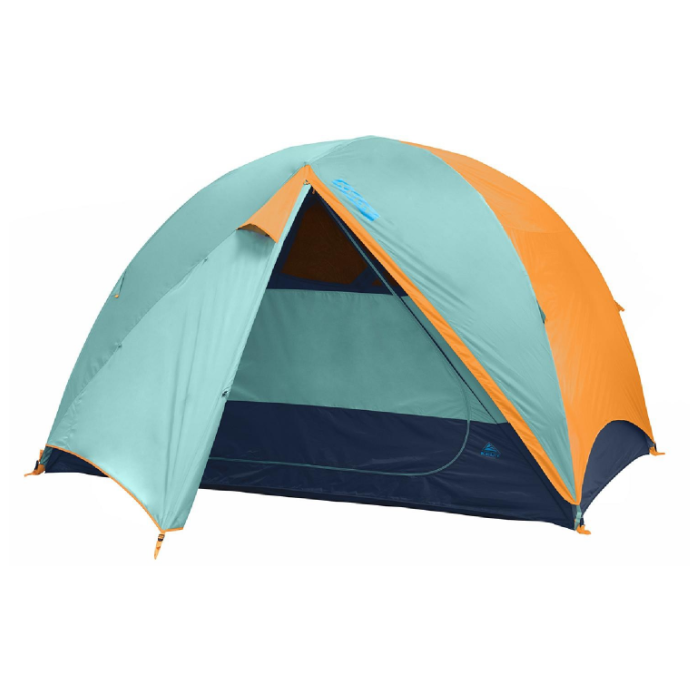
Kelty Wireless 6
Best Bang for Your Buck
CleverHiker Rating: 81.3/100
Price: $280
The size we tested feels: Luxurious for 2-3, comfortable for 4 & tight for 5
Weight: 17 lb. 3 oz.
Dimensions (LxWxH): 118 x 106 x 76 in.
Pros
- Huge interior
- Color-coded tabs for easy setup
- Less expensive
- Intuitive and fast to pitch
- Multiple sizes
- Excellent carrying case
Cons
- Footprint sold separately
- Only a few small internal pockets
- Doesn’t ventilate well
The Kelty Wireless 6 is a spacious and feature-forward shelter for six people, and one of our favorite budget options. In a market where most tents cost well over $300, including much smaller-sized options, the Wireless 6 is an economical breath of fresh air that offers everything you need and nothing you don’t.
It has a ton of interior room. With a 76-inch peak height, the Wireless offers one of the highest ceilings on this list, so you won’t have to stoop while you’re inside. The long brow pole pulls the interior walls taut and nearly vertical, increasing the livable space. We found there’s more than enough room to fit a family of four without feeling crowded, and for two people and a dog, it’s downright grand.
We like the Kelty Wireless for its cheerful and colorful aesthetic, but it’s more than just pleasing to the eye: the tent is color-coded to make pitching fast and easy. One of our favorite features is the deep pole pockets, which replace the need to carefully place pole tips in small grommets during setup. Simply nestle the poles in the tall pockets to keep them securely lodged as you clip the rest of the tent onto the frame.
Weighing in at over 17 pounds, the Wireless is one of the heavier tents we tested, although we can forgive the weight because it’s fairly durable. The seams are taped, the buckles are large and strong, and once staked, this tent is secure in any typical summer storms that roll through.
Our biggest complaint is the lack of ventilation in the Wireless. It features only two vents located on the downslope of the doors, and the interior has limited mesh. It holds heat for longer than you would expect after being pitched in the sun but this can be remedied by keeping the rain fly doors open and rolled back. We wouldn’t recommend this model for camping in continually hot, humid, and muggy places due to condensation buildup – but for most summer camping conditions, we think it’s a great choice.
If you’re looking for a tent with large vestibules, a big living space, and one of the easiest-to-use carrying cases we’ve seen, the Kelty Wireless 6 is a real bargain. Plus, this series comes in 2-person, 4-person, and 6-person versions, so you can find the perfect size for your next car camping adventure.
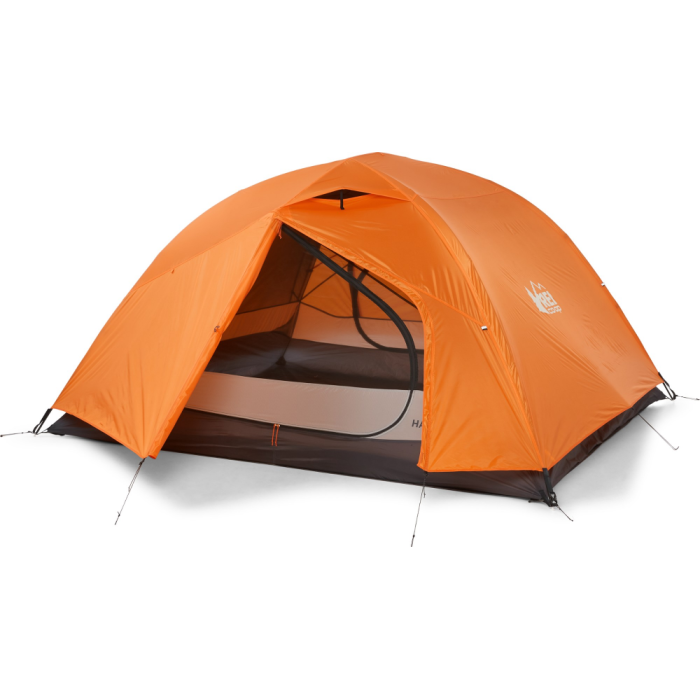
REI Half Dome SL 3+
Best Crossover Choice for Camping & Backpacking
CleverHiker Rating: 80.8/100
Price: $399
The size we tested feels: Comfortable for 2, tight for 3
Weight: 5 lb. 11.7 oz.with footprint
Dimensions (LxWxH): 90 x 78 x 44 in.
Pros
- High-quality poles & materials
- Quick & easy setup
- Lightweight
- Compact storage
- Two doors & vestibules
- Smooth zippers
- Good ventilation
- Good pockets
- Footprint included
Cons
- Low peak height
- Guylines not pre-attached
- Not enough stakes or guylines
We’re big fans of the REI Half Dome SL tents, and they’ve ranked at the top of the list for years. If you prefer the convenience of a low-profile and compact camping tent, but you still want the option to do some backpacking, the Half Dome series is a fantastic choice.
The Half Dome is not as spacious as most camping tents on this list. However, it’s much roomier than an average backpacking tent thanks to pre-bent poles that create vertical sidewalls. This translates to a ton of headroom, and lots of space to sit up and move around when sharing space with a furry friend or a hiking partner.
REI doesn’t cut corners on the essential features – the Half Dome offers a few well-placed pockets for stashing your phone or a headlamp, lots of floor space, and wide vestibules for any gear you want to keep close and out of the elements. It uses a time-tested design and familiar cross-X setup with a beefy brow pole, so it’s super fast to pitch and tear down.
Our favorite thing about the Half Dome is its versatility. It’s just light enough to take on short backpacking trips while being spacious enough for car camping. Even for the 3+, the split weight comes out to just under 3 pounds, which is reasonable for a backcountry weekend adventure.
This tent is more stable in high winds due to its lower profile and it’s very easy to pitch and take down. The Half Dome is a solid tent that feels comfortable, comes at a great price, and performs well in any weather.
More: Half Dome SL Full Review
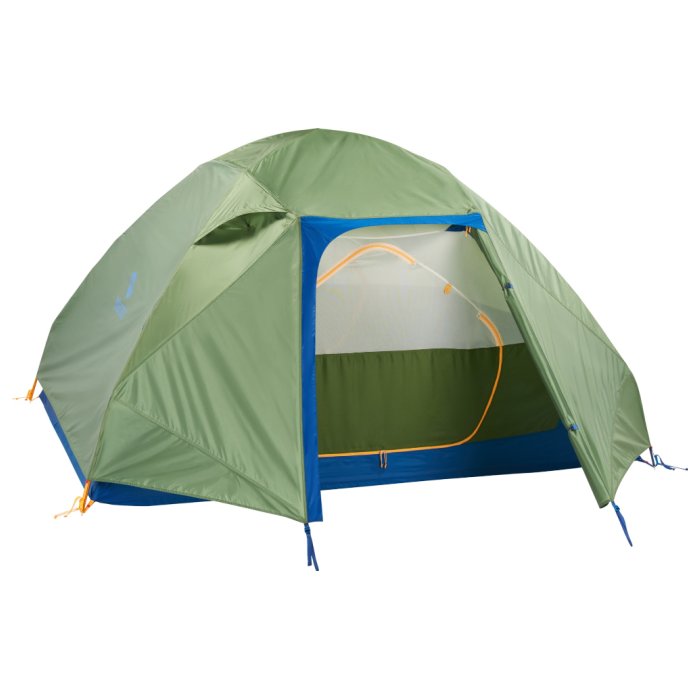
Marmot Tungsten 4
Best Low-Profile, High-Volume Camping Tent
CleverHiker Rating: 80.3/100
Price: $399
The size we tested feels: Luxurious for 2, comfortable for 3, tight for 4
Weight: 7 lb. 14 oz.
Dimensions (LxWxH): 93 x 82 x 52.8 in.
Pros
- Lightweight
- Fast & easy to pitch
- Spacious interior
- Durable materials
- Rainfly doors roll to side
- Footprint included
Cons
- Few pockets
- No guylines included
- Not enough stakes included
- Low peak height
If you’re looking for a low-profile tent that’s easy to use, fast to set up, and offers plenty of room for three people (or two people and a dog) the Marmot Tungsten 4 hits the sweet spot. It’s durable, sharp-looking, and will last for years.
The Tungsten is user-friendly and simple to pitch. We found two people can set up this tent in just a few minutes, but one person can also knock out these steps with ease. The hubbed pole structure is color-coordinated and is pre-bent to tension the tent perfectly.
The Tungsten is more spacious inside than it looks. With a ceiling height of almost 59 inches, it’s not quite tall enough to stand up in for most people, but this lower profile performs better in howling winds and rain. The Tungsten’s ceiling is about 10 inches taller than the REI Half Dome, which means more room to stretch your arms when you’re waking up in the morning. Plus, this tent features two brow poles to maximize headroom when you’re sitting up and moving around.
We like the L-shape doors of the rainfly since they can be completely rolled to one side and out of the way for easy in and out. The downside of this design? You sacrifice a bit of storage space in the vestibules. There’s still enough room for shoes and a backpack, but it’s less roomy than comparable tents.
The Tungsten is lower on our list because it only has a few small internal pockets, so we quickly ran out of space to stash extra clothes and small items. And, Marmot doesn’t include any guylines with this tent. If you’re planning on camping on a windy butte in Utah or a fall storm in the high Rockies, be sure to pick up your own guylines and a few extra stakes to keep your tent securely attached to the ground.
When it comes to car camping, we love a hassle-free, reliable, and well-built tent that packs up small, and the Marmot Tungsten is a good choice. For those who don’t mind spending a bit more for a high-quality tent that feels big but packs small, this is the tent for you. And if you’re looking for a smaller size, it also comes in ultralight (for backpacking) as well as 1-, 2-, and 3-person versions.
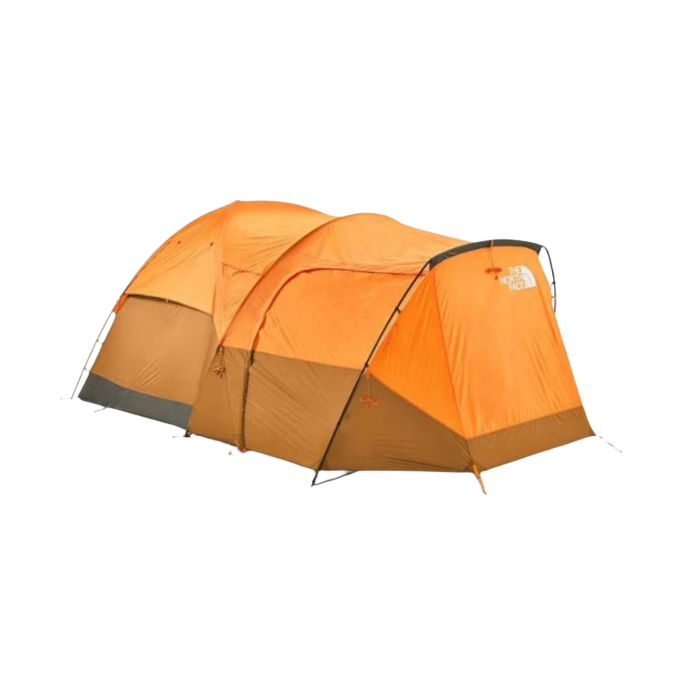
The North Face Wawona 6
Sturdy & Comfortable Camping Tent with a Large Vestibule
CleverHiker Rating: 80/100
Price: $500
The size we tested feels: Luxurious for 3-4, comfortable for 5 & tight for 6
Weight: 21 lb. 14 oz.
Dimensions (LxWxH): 120 x 96 x 76 in.
Pros
- High-quality fabric & poles
- Huge interior space
- Smart pockets & organization
- Many guyline attachment points
- Tall ceiling
- Massive vestibule
- Effective vents
Cons
- Heavy
- One door
- Takes time to pitch
- Footprint not included
If you’re looking for a tent with the largest vestibule for your family outings, a summer trip with a group of friends, or adventures with lots of gear, The North Face Wawona 6 is your camping castle. Its vestibule, clever interior design, and outstanding ventilation make for a very comfortable place to sleep, hang out, and stage your next activity.
When it comes to vestibule size, The Wawona is in a class of its own: the front vestibule is a whopping 44 square feet at the front, creating an entire additional covered space big enough to sleep in.
Not only are these spaces ideal for stashing the typical muddy shoes, wet gear, and bulky items like backpacks, but the spacious vestibules can accommodate multiple bicycles, bins of gear, or up to three camping chairs and a small table to relax during a rainy afternoon. Although neither vestibule has a separate screen to keep out bugs, we don’t mind too much.
We appreciate the plentiful pockets and different-size storage pouches throughout the tent for stuffing everything from light jackets and hats to lighters and charging wires. Extra features like a lantern loop in the center ceiling, color-coordinated poles for easy setup, plus an all-mesh door and vent kickstands keep air moving and prevent condensation from building up on humid nights.
Having said that, we found the Wawona a bit more challenging than average to pitch so we highly recommend finding an extra set of hands to help speed up the process. The tall height of the tent makes it vulnerable in high wind, so knowing how to secure it properly is essential for wind and storms.
The biggest con of the Wawona 6 is its price and weight. This is one of the priciest camping tents we tested – and one of the heaviest as well. That said, we don’t carry it too far from our vehicles, and it offers outstanding value. The excellent use of space and storage, durable build, and versatile, oversized vestibules make it an unmatched basecamp tent for two to five people and a dog.
The generous 76-inch ceiling height, burly aluminum poles, and enormous vestibule could make this your go-to tent for years to come. If you’re the type of camper who likes to set up for days at a time (or longer) and satellite from that location for your outdoor adventures, this option is worth every penny.
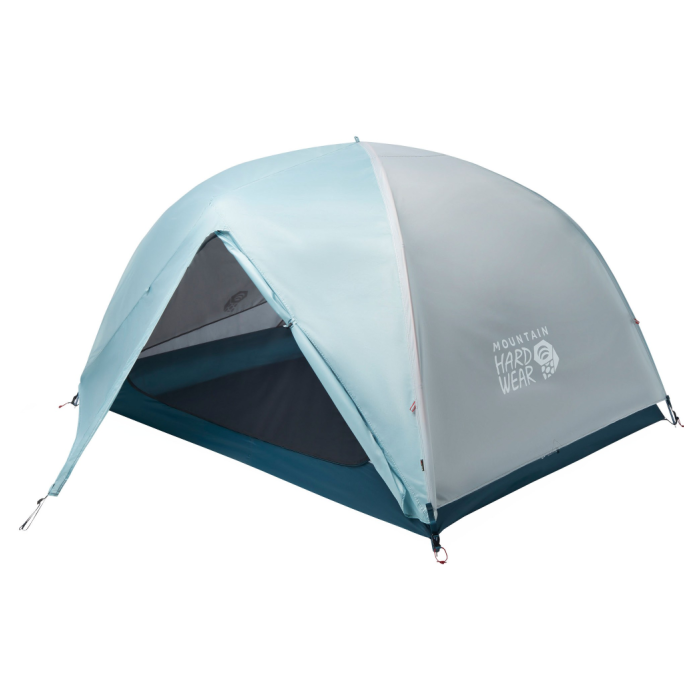
Mountain Hardwear Mineral King 3
High-Quality & Durable Camping Tent for Two
CleverHiker Rating: 79.8/100
Price: $375
The size we tested feels: Luxurious for 1, comfortable for 2 & tight for 3
Weight: 7 lb. 1.2 oz.
Dimensions (LxWxH): 90 x 68 x 48 in.
Pros
- Lightweight
- Easy and intuitive to pitch
- Huge doors with out-of-the-way stuff pocket
- Pre-bent poles create plenty of internal room
- Dual zippers on fly with kickstand for ventilation
- Fly rolls up halfway
- Plenty of pockets
- Packs small
Cons
- Lower peak height
- All-mesh upper limits privacy without fly
- Heavy for its size
The Mountain Hardwear Mineral King 3 is a dream for summer camping. Thanks to its all-mesh upper, versatile fly design, and enormous doors, this high-quality and familiar tent feels like a castle for one person, or a cozy shelter for two.
We love the Mineral King 3’s all-mesh canopy and smart fly design for its breathability in the summer. There’s almost no nylon on the interior walls so it offers unrivaled ventilation on warm trips where a cool breeze at night is a priority. Plus, the tent fly can be rolled up halfway to the center of the ceiling so you can take in the views of the Milky Way at night. Or the fly can be quickly rolled back down when wet weather moves in.
The Mineral King is as livable as 3-person tents come. The pre-bent poles make for a fast and easy pitch and the five pockets offer all the storage we want. Tall dual kickstands and double zippers on the rainfly doors keep the rain out while allowing for good ventilation when conditions are muggy.
This model offers the widest doors of any 2- or 3-person tents we’ve tested. They span almost the entire length of the interior on both sides, so accessing gear is a breeze. When open, the mesh doors stash easily in a smartly placed pocket to keep them off the ground. We like this design and generally prefer stuff pockets for door flaps so we’re not constantly fiddling with tabs and loops to keep the doors open.
Our biggest gripe with this tent is its low ceiling height. At 48 inches, it’s one of the lowest peak heights on this list, so you’ll want to keep looking if standing up inside your shelter is a top priority. That said, the Mineral King offers plenty of headroom for two people to sit up and move around without feeling cramped. Plus, this low profile is advantageous in summer storms. When driving rain and whipping wind pick up, the Mineral King feels secure and will reliably keep you and your gear bone dry.
Though the Mineral King 3 is a bit heavy for its size, this tent is tough to beat when it comes to a well-ventilated, easy-to-use shelter for one or two people looking for a 3-season car camping option. If you need a shelter that packs small, has plenty of storage, and is built to last season after season, this is the tent for you.
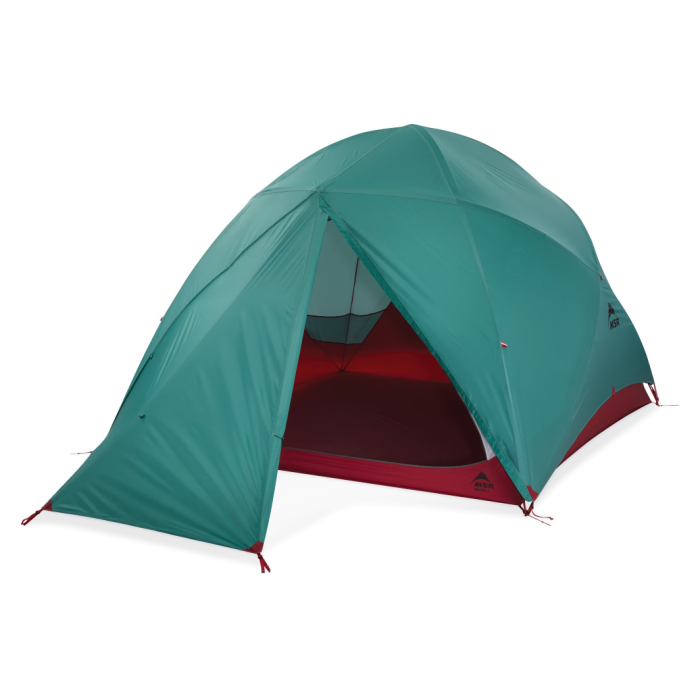
MSR Habitude 6
Best Premium Camping Tent for Families & Groups
CleverHiker Rating: 787.5/100
Price: $700
The size we tested feels: Luxurious for 3, comfortable for 4, tight for 5+
Weight: 14 lb.
Dimensions (LxWxH): 95 x 95 x 73 in.
Pros
- Top-quality build & materials
- Tall ceiling height
- Huge vestibule & interior
- Tons of pockets
- Excellent in wet weather
- Effective insulation
- Built-in “porch” light
Cons
- Very expensive
- Tough to pitch solo
- Only one door
- Small storage bag
The MSR Habitude 6 is the king of stormproof, premium tents. For families and groups who want the best of the best when it comes to 3-season weather protection and organization, the Habitude is an outstanding basecamp.
This model is impressively spacious, but the simple square design of its floor lets it fit easily into tighter campsites. We fit three wide sleeping pads with no issue, but the Habitude is more than big enough for four or five people (with regular-size pads) without feeling cramped. Plus, the peak height is well over six feet – plenty of room to stand up to change clothes.
Our favorite comfort feature of the Habitude – besides the many well-placed pockets – is the built-in “porch light”, a push-button light embedded in the aluminum poles of the awning, positioned above the single entryway. This is a welcome touch during moonless evenings, midnight bathroom breaks, and rainy early mornings when you make it back to your tent.
We think the Habitude 6 is the most weather-resistant, lightweight (for its size) 3-season tent on the market. Tents of this height – over 6 feet – can feel like a sail flapping in the wind when weather turns, but the Habitude’s flexible pole structure and strong materials make it a reliable shelter in driving rain, intense winds, and summer storms.
The main bummer is the price tag. At $700, this is one of the most expensive camping tents we’ve ever tested. But, you truly get what you pay for with this tent – one of the most weather-resistant, high-quality, durable, and well-organized shelters out there. For a less weather-worthy but more feature-forward version, check out the Habiscape 6.
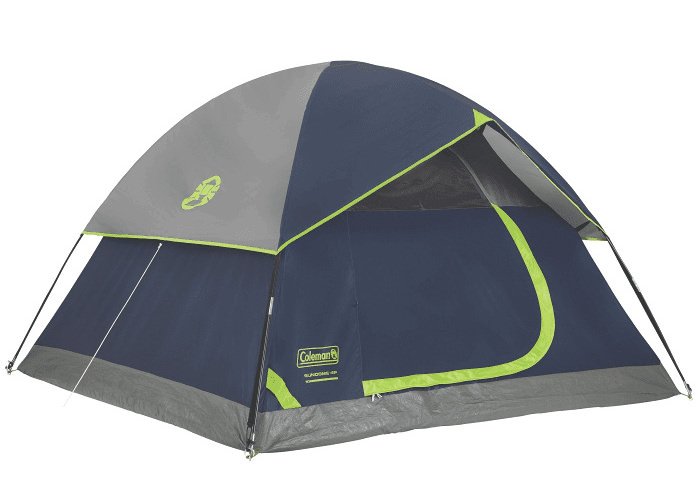
Coleman Sundome 4
Budget Camping Tent with a Partial Rainfly
CleverHiker Rating: 62.3/100
Price: $100
The size we tested feels: Luxurious for 2, comfortable for 3, tight for 4+
Weight: 10 lb. 3 oz.
Dimensions (LxWxH): 108 x 84 x 59 in.
Pros
- Affordable
- Quick & easy set up
- Relatively lightweight & compact
- Includes all guylines
- Includes stakes & doormat
Cons
- Partial fly does not fully keep out rain
- Lower-quality poles & materials
- Not fully seam-sealed
- Single door
- Door zippers tend to snag on mater
- No vestibule
The Coleman Sundome 4 is the most affordable tent on this list. It’s popular because it’s so inexpensive (and almost always on sale somewhere) but is still relatively light and compact for its size. If you’re looking for a budget-friendly shelter for occasional camping on bluebird days and calm nights in the front country, the Sundome may be all you need.
Coleman keeps the weight of the Sundome down with lightweight fiberglass poles that create a simple and familiar structure. It’s straightforward to set up, and one person can pitch the tent in less than eight minutes, but an extra set of hands is helpful. An extended brow pole keeps the partial rainfly away from the windows, and a separate door mat is a welcome place to sit or stand while pulling on shoes or a jacket.
We appreciate the Sundome for its spacious interior. We easily fit three regular camping pads and a dog bed in the tent and had plenty of room to spread out. The peak height is just shy of five feet, so we couldn’t stand fully upright, but the lofty headspace is helpful for moving around.
For such a low price, though, you’ll sacrifice reliability and longevity. The poles and fabric of the tent are not durable compared to others on this list. We learned this when a pole broke and ripped through the fabric after a handful of uses in fair weather.
The budget-friendly price also means that most of the seams are not sealed, so this is not the tent to choose if there is moisture in the forecast – although it will dry fast after a passing rain cloud. The zippers on both windows and doors are clunky and tended to catch on the overlapping fabric. The partial rainfly attaches loosely to the frame with plastic hooks, and a single brow bar keeps the thin fabric balanced on top of the tent. A sustained moderate wind will unhook the rainfly from its position, so camping in anything but bluebird conditions may yield some interior moisture.
However, if you need a simple and inexpensive tent for a few nights of fair-weather camping here or there, the Sundome will do a fine job. For those who want an economical tent for an overnight in the backyard with the kids, a couple of mild weekends of front-country camping over a holiday weekend, or events like a multi-day festival, the Sundome is a decent option.
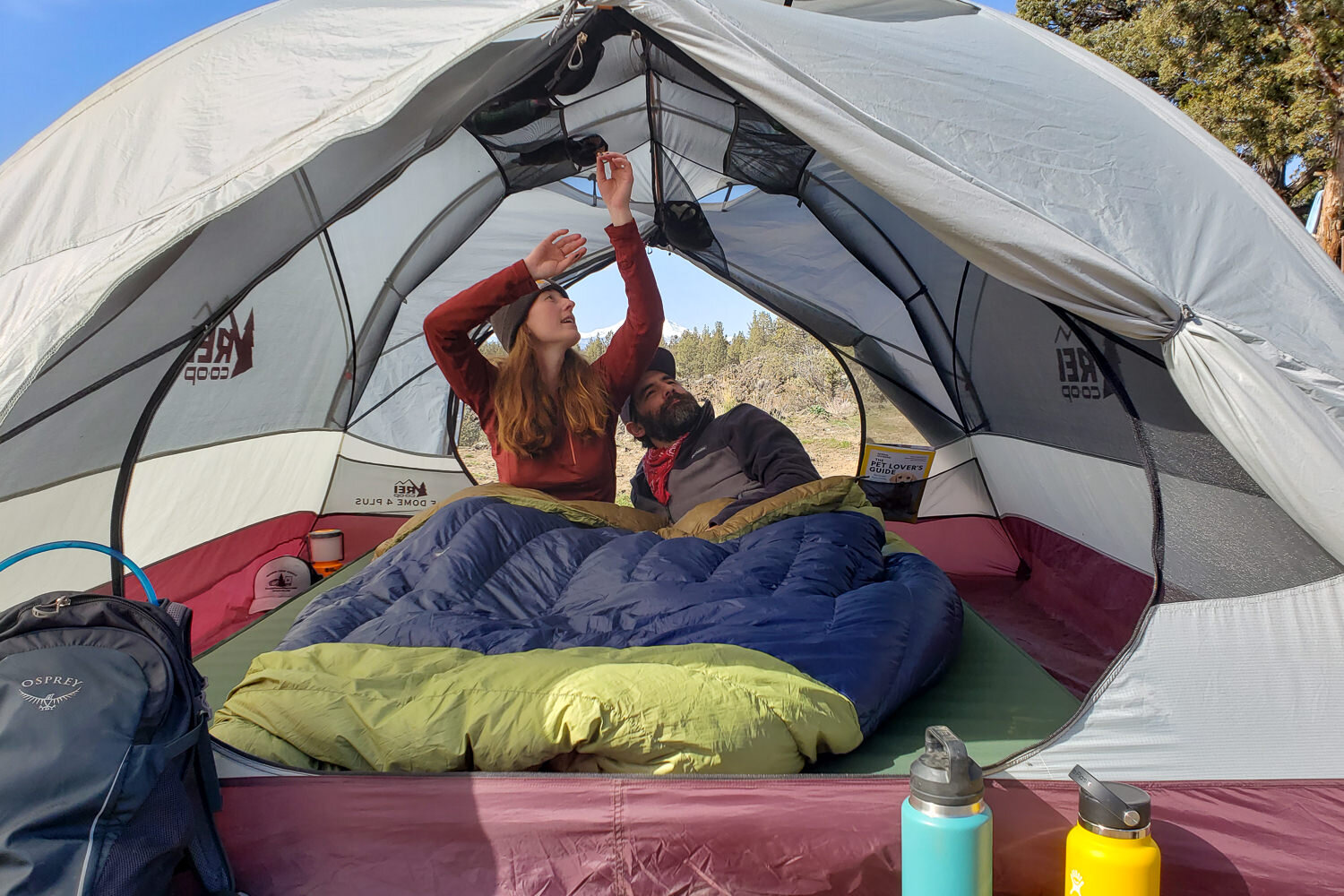
Product Comparison Table
| oSort | Product | Price | Weight | Dimensions (LxWxH) | Comfort | Ease of Setup | Weather Resistance | Durability | Features | 0 |
NEMO Aurora Highrise 4 View at REI View at Amazon |
$400 | 15 lb. 14 oz. | 100 x 90 x 75 in. | 8 | 9 | 8 | 9 | 8.5 | 1 |
REI Wonderland 4 View at REI |
$429 | 21 lb. 11 oz. | 120 x 100 x 75 in. | 9 | 8.5 | 8.5 | 7.5 | 8.5 | 2 |
Kelty Wireless 6 View at Amazon |
$280 | 17 lb. 3 oz. | 118 x 106 x 76 in. | 9 | 8.5 | 8 | 7.5 | 7 | 3 |
REI Half Dome SL 3+ View at REI |
$399 | 5 lb. 11.7 oz. with footprint | 90 x 78 x 44 in. | 7 | 8.5 | 9 | 8.5 | 8 | 4 |
Marmot Tungsten 4 View at REI View at Amazon |
$399 | 7 lb. 14 oz. | 93 x 82 x 52.8 in. | 7 | 8.5 | 9 | 8.5 | 7.5 | 5 |
The North Face Wawona 6 View at REI View at Amazon |
$500 | 21 lb. 14 oz. | 120 x 96 x 76 in. | 9.5 | 6 | 8 | 7.5 | 8 | 6 |
Mountain Hardwear Mineral King 3 View at REI View at Mountain Hardwear |
$375 | 7 lb. 1.2 oz. | 90 x 68 x 48 in. | 8 | 8.5 | 9 | 7.5 | 7 | 7 |
MSR Habitude 6 View at MSR View at Amazon |
$700 | 14 lb. | 95 x 95 x 73 in. | 6 | 7 | 7 | 10 | 9.5 | 8 |
Coleman Sundome 4 View at Amazon |
$100 | 10 lb. 3 oz. | 108 x 84 x 59 in. | 8 | 6.5 | 5 | 5 | 6 |
|---|
How We Test & Methodology
SPACIOUSNESS & COMFORT
Spaciousness and comfort is about the livability of a tent. We look at the interior dimensions and how many people can comfortably sleep inside. Peak height is also an important factor, and we are sure to assess not only whether or not taller folks can sit up or stand, but how much room is actually available at shoulder height and above. Door size and configuration also plays a role here.
EASE OF SETUP
The tents that lead in this category have intuitive and clear instructions that streamline and speed up assembly. We scrutinize the weight and packability of the tent, as smaller and lighter models are easier to transport and store. We look for features like color-coded poles and clips that can simplify setup, as well as adjustable guy lines and tensioners that help stabilize your tent when the weather turns.
WEATHER RESISTANCE
When looking at weather resistance, we examine the materials used to construct the tent, prioritizing the most durable fabrics with robust waterproof coatings that repel rain and moisture effectively. We inspect seams for their quality and check their waterproofing since seam-sealed stitching prevents water from seeping into the tent during heavy downpours. Additionally, we look at the tent’s design, accounting for its shape, height, and geometry, to determine how well it handles strong winds and gnarly weather conditions. We take note of features like reinforced guy line attachments and sturdy pole structure, which keep the tent stable. We also look carefully at auxiliary features like rain flies and vestibules, which provide added protection for the gear you don’t want in your living area but still need to keep dry.
DURABILITY & QUALITY
Here, we prioritize the strength and durability of a tent’s materials – including poles, fabric, and hardware – to see how they stand up to the elements and how they handle being set up and taken down hundreds of times over multiple seasons. We examine the quality of stitching and seam sealing to make sure there aren’t any leaks as well as the tent’s structural integrity, since reinforced tent stress points and heavy-duty zippers help with durability even in whipping wind.
FEATURES
Some models have additional features that go above and beyond the baseline. We test them all from the number, size, and location of storage pockets to stuff sacks, included footprints, and clothesline systems.
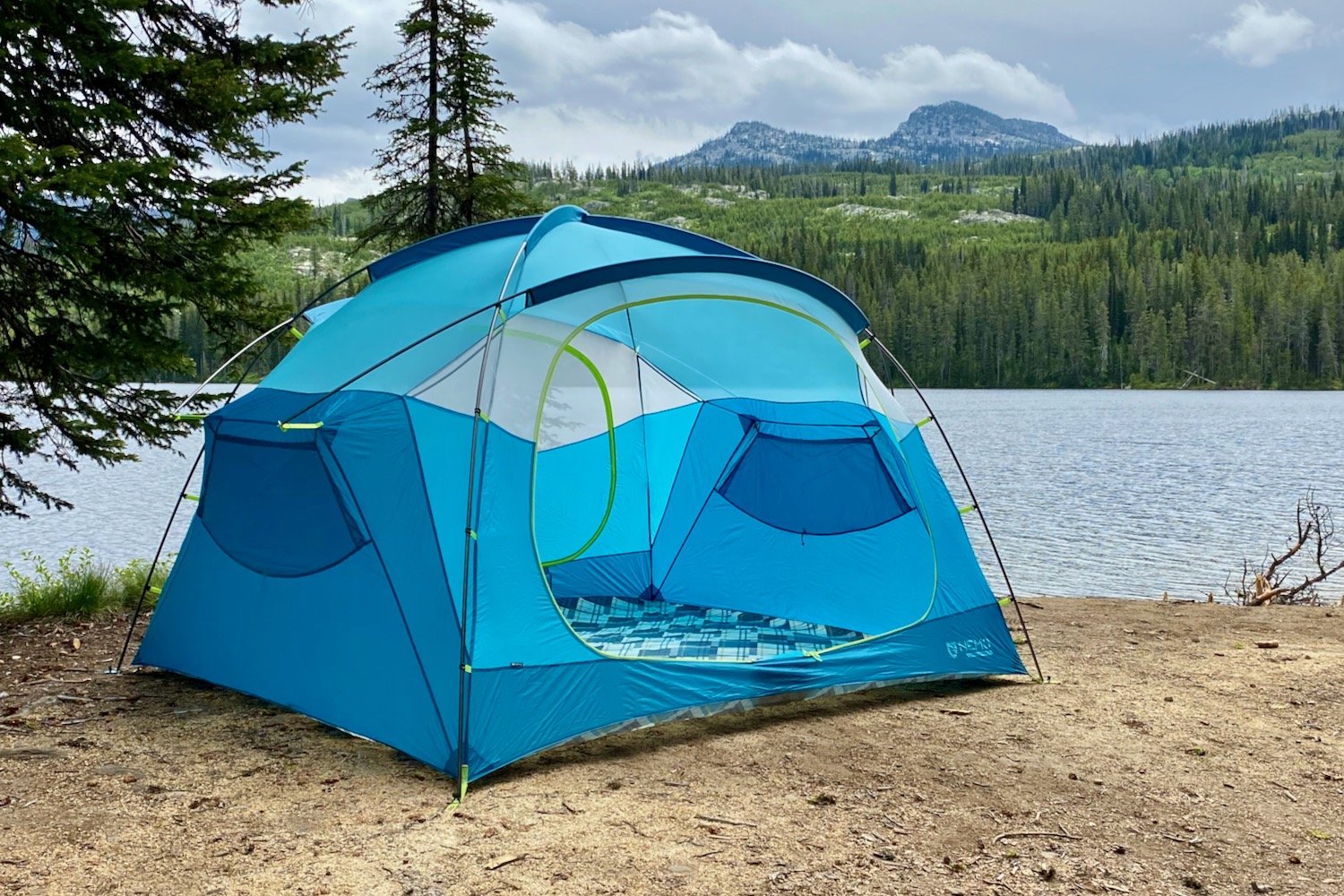
Why Trust CleverHiker
Our team has collectively spent over 3,000 nights camping to find the top-performing tents. Gear Analyst and lead tester, Ian Krammer, has pitched tents all over the state of Colorado, camping in almost every national forest, wilderness area, and 4WD accessible trailhead and basin in the state over the last 15 years. His extensive experience with camping tents, as well as his history working in comparative research, has refined his ability to meticulously evaluate each tent to identify the best features and potential shortcomings. This rigorous testing means that the tents we recommend are truly top-notch.
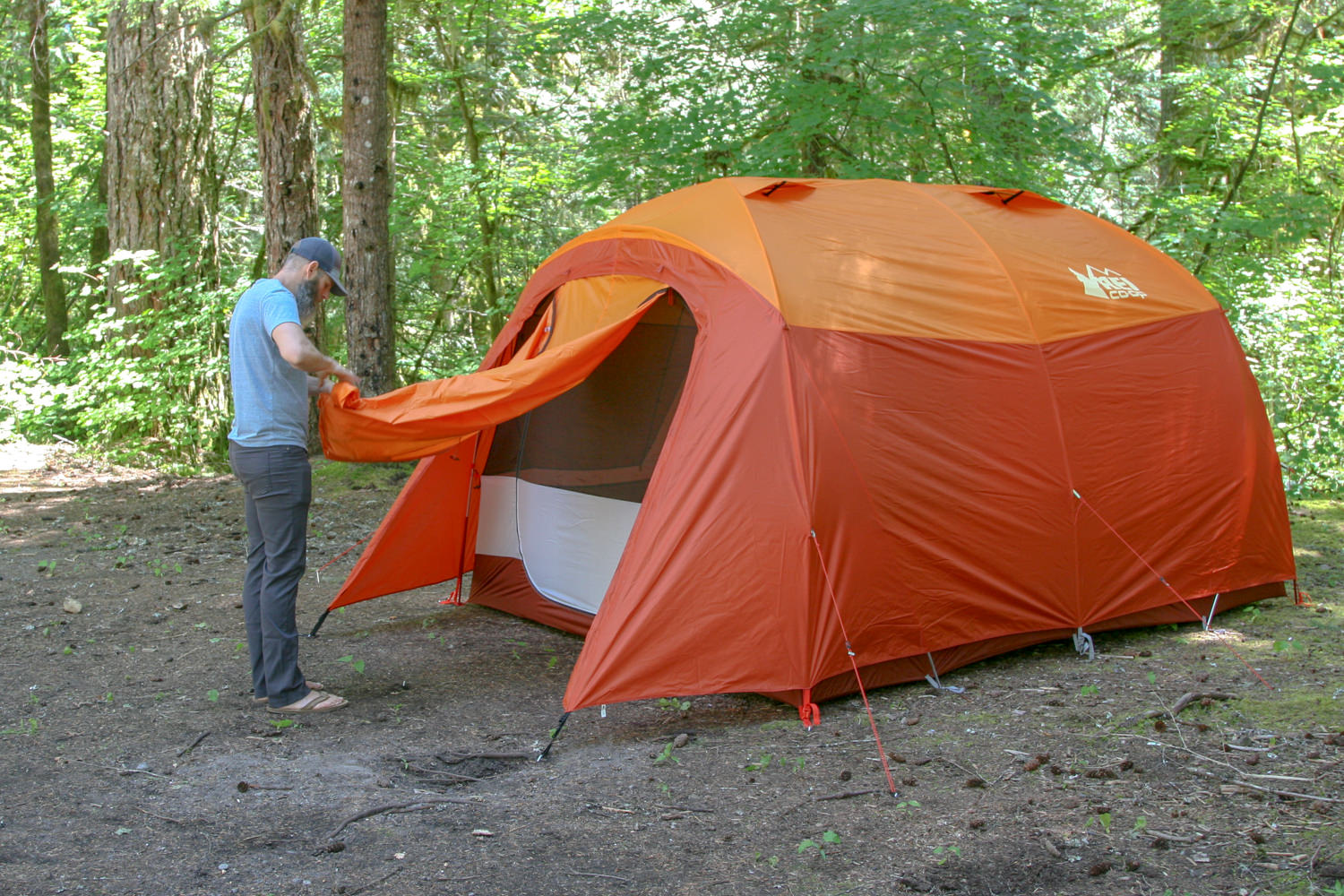
Analysis & Results
We evaluate tents based on five criteria: comfort, durability, weather resistance, ease of setup, and features. Our comparison below highlights the top performers in each metric.
VALUE
No matter what your budget is, we recommend camping tents at a variety of price points to help get you out there. For us, value is not synonymous with inexpensive or budget. Though there are certainly many good options at a reasonable price, value is overall performance relative to price. So there may be some excellent options that are justifiably expensive as well as cheaper ones that outperform expectations.
The Kelty Wireless 6 offers some of the best value in the camping tents category. Despite being one of the least expensive tents that we tested, we found it to be made of surprisingly high-quality materials. The Wireless 6 has a robust set of features, dual vestibules, color-coded pole masks, and it’s held up well to some pretty nasty rain and thunderstorms.
If you can stretch your budget, you can upgrade to a higher-quality tent, such as the NEMO Aurora Highrise which offers excellent value. While its price point is higher thanif you some others, the NEMO Aurora Highrise gets high marks for combining high-end features with incredible durability. If you’re looking for a tent that will last year after year, this one is a standout choice for comfort and convenience in a 4-person and 6-person model. This one has a tall ceiling, tons of interior space, and premium materials making it very durable in wild weather.
The Mountain Hardware Mineral King 3 also offers a remarkably good value for a tent that can be used for both front country camping and also as a backpacking tent in a pinch. While larger than most backpacking tents available on the market, it’s significantly smaller than the tents listed above when all packed up. Even though it’s small and relatively inexpensive, it still has a lot of the features that you’ll find in the tents on the rest of our list. The Mineral King 3 gets bonus points because it actually comes with a footprint at no added cost.
Lastly, if you are looking for something with a ton of space, features, top-of-the-line materials, and an exceptionally well-rounded design there is a lot of value to be found in the North Face Wawona 6. The Wawona 6 tops the list of our favorite tents this year and value is a big part of that designation.
COMFORT
The North Face Wawona 6 is exceptional for space and comfort with its high peak height and expansive floor area, offering a ton of room for four or more campers to move around comfortably. It features the largest front vestibule on our list – as well as a large rear vestibule – that dramatically extends the livable space of the tent. This vestibule easily serves as storage for bulky equipment like chairs, mountain bikes, or even a small table. It offers double doors for easy access and the near-vertical walls and large mesh windows make this one of the most livable tents we’ve tested.
The Kelty Wireless 6 is also at the top of our list for its generous space and comfort. With a large footprint and a spacious interior that easily accommodates a family of four to five people, its tall ceiling allows for standing room, its dual vestibules – although smaller than the Wawona – provide plenty of additional storage space for gear. Two doors offer convenient entry and exit, and the mesh walls provide excellent visibility outside when the fly is back.
If you’re looking for one of the most premium options out there the MSR Habitude 6 Is tough to beat. Although the ceiling height is several inches shorter than the Wireless or the Wawona, it still feels cavernous, and there’s tons of room to spread out as needed. The large floor plan accommodates four people with no problem, and the Habitude has plenty of room and well-placed, oversized pockets for extra gear. We also love the large doors for easy entry and exit.
The REI Wonderland 4 is one of the heaviest tents we looked at – but it also has one of the largest interiors. When it comes to livability, this one is a great option thanks to its dome-style design that maximizes interior volume and headroom. It provides ample space for three or more campers, with two large doors for easy in and out. The big storage pockets, internal gear loops, high-quality materials, and thoughtful design details make this one of the comfiest for camping in a group.
DURABILITY
If you’re looking for a tent that will last for an incredibly long time, the MSR Habitude 6 takes the top spot. MSR offers outstanding durability and quality with this model, including top-tier materials like ripstop nylon fabric and DAC aluminum poles to ensure long-lasting performance season after season. Its meticulous attention to detail, including reinforced stitching, precision-engineered components, and a burly storage bag make it one of the most reliable choices on the market for extended outdoor adventures.
We also love The North Face Wawona 6 for its durability and quality construction. It boasts rugged materials like hearty polyester and sturdy aluminum poles that will withstand years of repeated use from spring until fall. Its robust design, including fully taped seams and heavy-duty zippers, make for superior weather resistance and longevity. This tent is one of our trusted shelters in all sorts of conditions year after year.
The NEMO Aurora Highrise 4 is another ultra-premium option that excels in durability, dependability, and quality. It uses the best of the best materials like polyester fabric and DAC Featherlite NSL aluminum poles. Its meticulous craftsmanship, including precision seam sealing and reinforced stress points, guarantees long-term reliability and performance.
Also, take a close look at the REI Half Dome SL 3+. For years, this tent has stood out against the competition for its durability and exceptional build quality. The Half Dome’s thoughtful construction details, including welded corners and color-coded pole clips, exaggerate its structural integrity and increase its weather resistance, making this one a trusted companion for years and years of camping adventures.
WEATHER RESISTANCE
The MSR Habitude 6 is outstanding when it comes to weather resistance. While taller tents like the Habitude generally don’t do well in high winds and driving rain, the robust pole structure and full-coverage rainfly all but guarantee stability when the storms roll in. The tent’s high-performance materials like thick, waterproof fabric and reinforced seams, and burly guy out lines and reinforced attachment points make it capable of withstanding intense weather conditions without sacrificing space.
As one of the lowest-profile tents on our list, the Mountain Hardwear Mineral King 3 is built to withstand harsh weather. Its fully seam-taped rainfly and bathtub-style floor provide excellent protection against gnarly thunderstorms. We trust this one as one of the most stable and durable tents on the market, perfect for high winds and unexpected summer storms. But, this is one of our top choices for when the storms pass, too, since the interior tent walls and ceiling are all mesh, making for one of the most breathable tents we’ve reviewed.
Similar to the Mineral King, the REI Half Dome SL 3+ is another fairly low-profile option with superior weather resistance. Its full-coverage rainfly and robust pole architecture lend awesome stability and protection in windy conditions. The tent’s durable fabric and reinforced corners ensure it can handle heavy rain and snow and the guy out lines will lock the tent to the ground, keeping you dry and secure during inclement weather.
Finally, and somewhat surprisingly, we found The North Face Wawona 6 to hold up surprisingly well to some really wild weather. We were able to pitch our Wawona six on a fairly exposed mountaintop just before a very gnarly Colorado monsoon blew through. The tent held strong even in 40-50 mile per hour winds. It was a bit noisy but never felt like it was going to collapse on up.
Taller tents such as the REI Wonderland suffered a bit in high winds but still remained surprisingly waterproof. The Kelty Wireless 6 worked well in both high winds and heavy rain but we did find some seepage through the floor after a couple of days of rain.
EASE OF SETUP
The Mountain Hardwear Mineral King 3 is exceptionally easy to set up thanks to its color-coded pole system and lightweight design, which allow for quick and intuitive assembly. As one of the lightest options on our list, and with a lower ceiling and profile, this one is simple for one person to set up. Its straightforward, freestanding structure and pre-bent poles make it a dream to pitch with minimal effort.
Similarly, the REI Half Dome SL 3+ is very lightweight compared to most of the bigger tents on this list. Its hubbed pole system and color-coded clips streamline the setup process for a speedy pitch. The tent’s freestanding design, combined with its airy materials, allows for easy solo setup even when the wind is howling or the rain is rolling in.
The NEMO Aurora Highrise 4 also stands out for its ease of setup, with a simple pole design and intuitive setup instructions that make it possible for one person to set up the tent fairly quickly. This model’s long pole sleeves, familiar structure, and snap-on pole clips make for a truly efficient and hassle-free setup.
Other tents like the North Face Wawona 6 and REI Wonderland 4 are a little more complicated to set up due to their large size and more complex designs. They can still be set up by one human but having a partner wouldn’t be a bad idea.
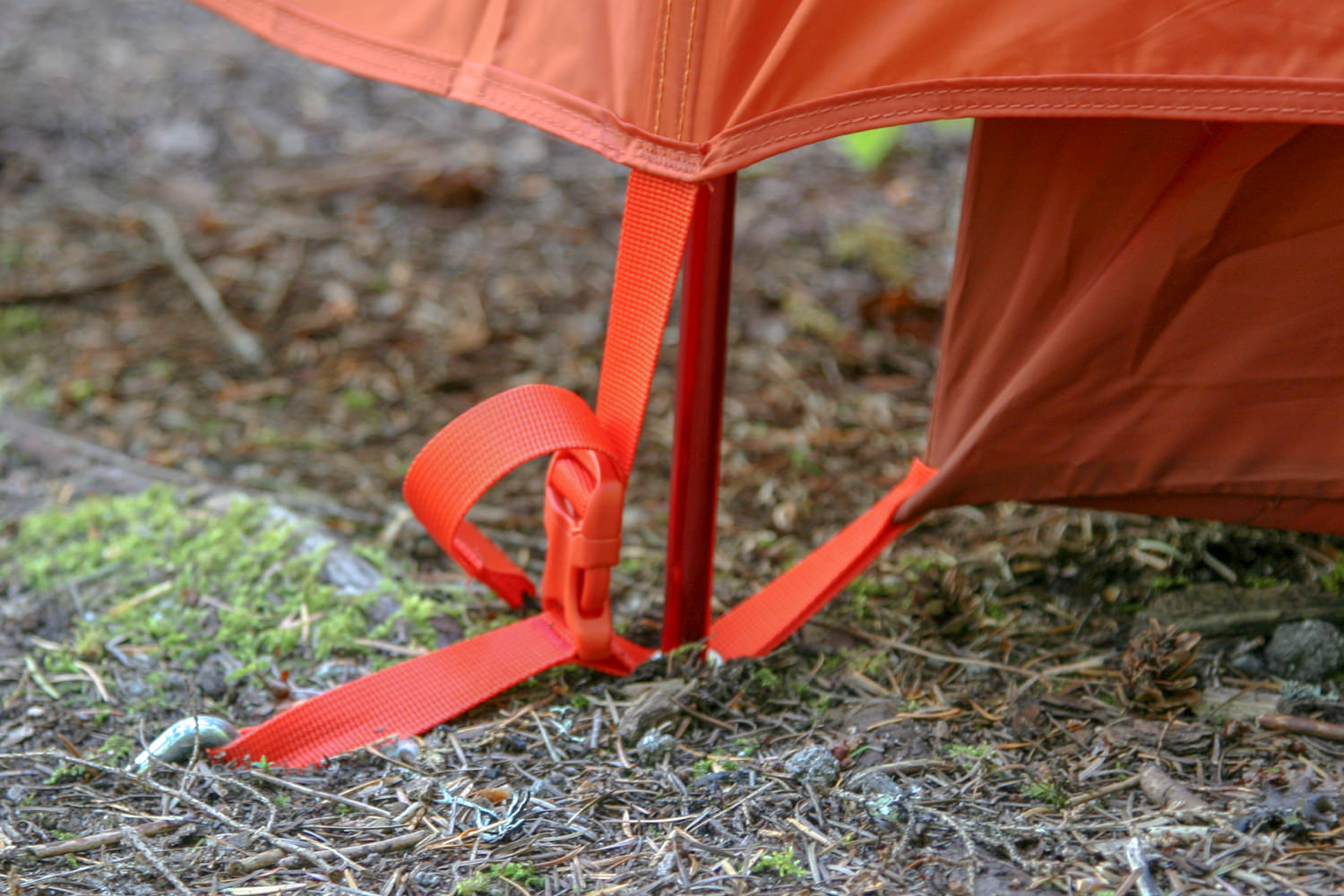
FEATURES
The North Face Wawona 6 stands out for its absolutely enormous vestibule. It has the largest vestibule area of any tent on our list, in some cases two to three times bigger than others we’ve looked at. This uniquely oversized space provides an entirely separate sheltered area to serve as a living room when the weather turns or a large storage area for oversized gear like backpacks or bikes. It also has more internal pockets than our other top contenders like the REI Wonderland 4 and the NEMO Aurora Highrise 4.
The MSR Habitude 6 is the boss when it comes to lighting. This one shines with its built-in “porch” light, a push-button light above the door for added visibility at night. This is an excellent design choice that makes it easy to see the gear in your vestibule without lighting up the interior of the tent.
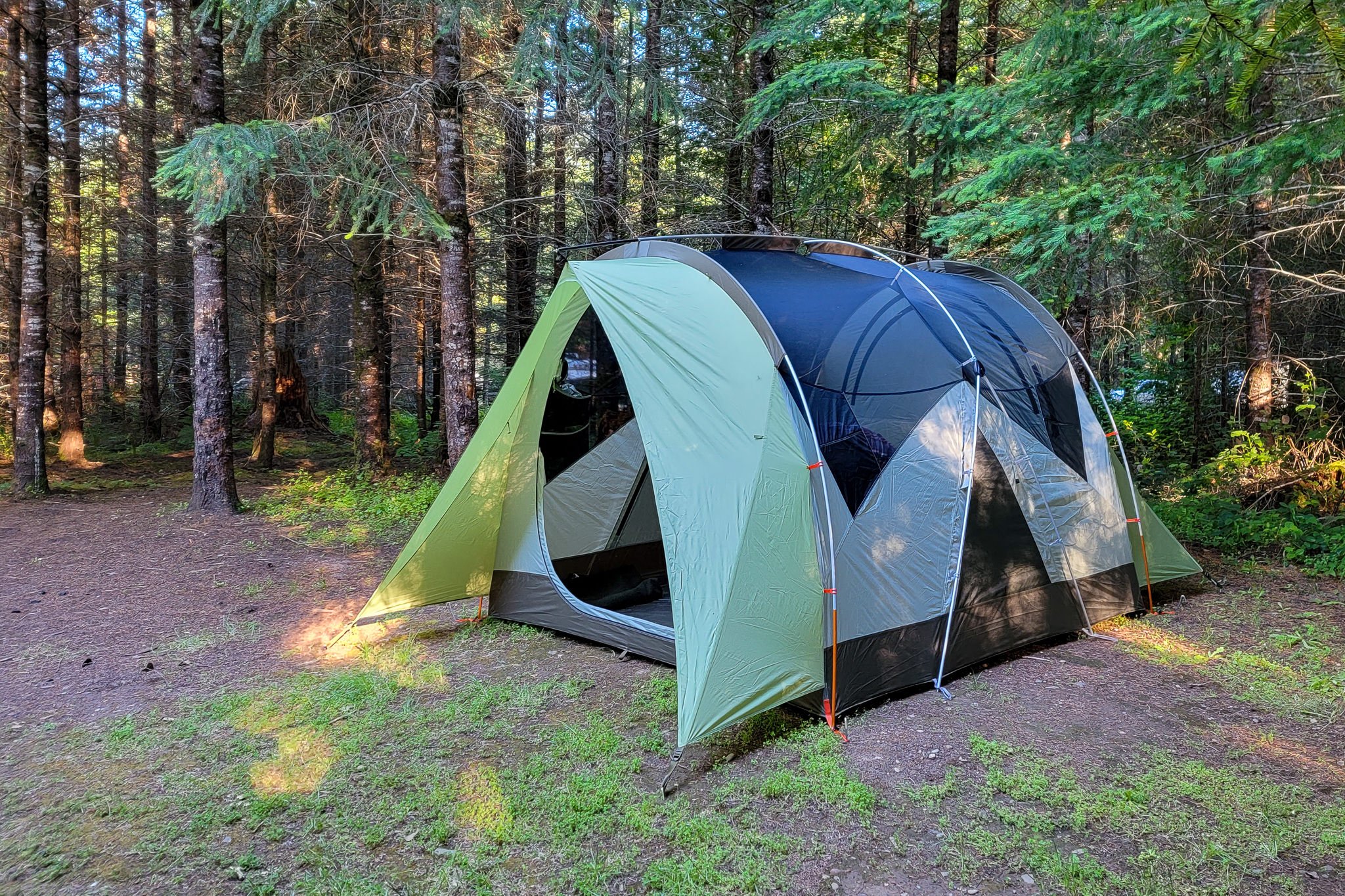
How to Choose a Camping Tent
SPACE & CHOOSING A TENT SIZE
Capacity ratings usually overstate the number of people (and sleeping pads) that fit in a tent, so don’t rely on that number unless you enjoy sleeping like sardines. A good rule of thumb is to go up in size by one or two people for additional space and more comfort. If you’re tall, claustrophobic, or you share a tent with children or pets, a little extra elbow room will make your trip much more enjoyable. You could also consider using multiple small tents in place of one large tent to accommodate groups. In our experience, kids are typically stoked to have their own tent. If you’re unsure what size will work best for your group, check out our Tent Size Guide.
PEAK HEIGHT
If you’re camping for multiple days, spend a significant amount of time hanging out in your tent, or use it a lot in a season, choose one that’s tall enough to stand and move around in. Tents with high peaks and near vertical walls have the most usable space, but they are more susceptible in windy and stormy conditions. Be sure to use the appropriate stakes and guylines to help support larger tents and avoid issues.
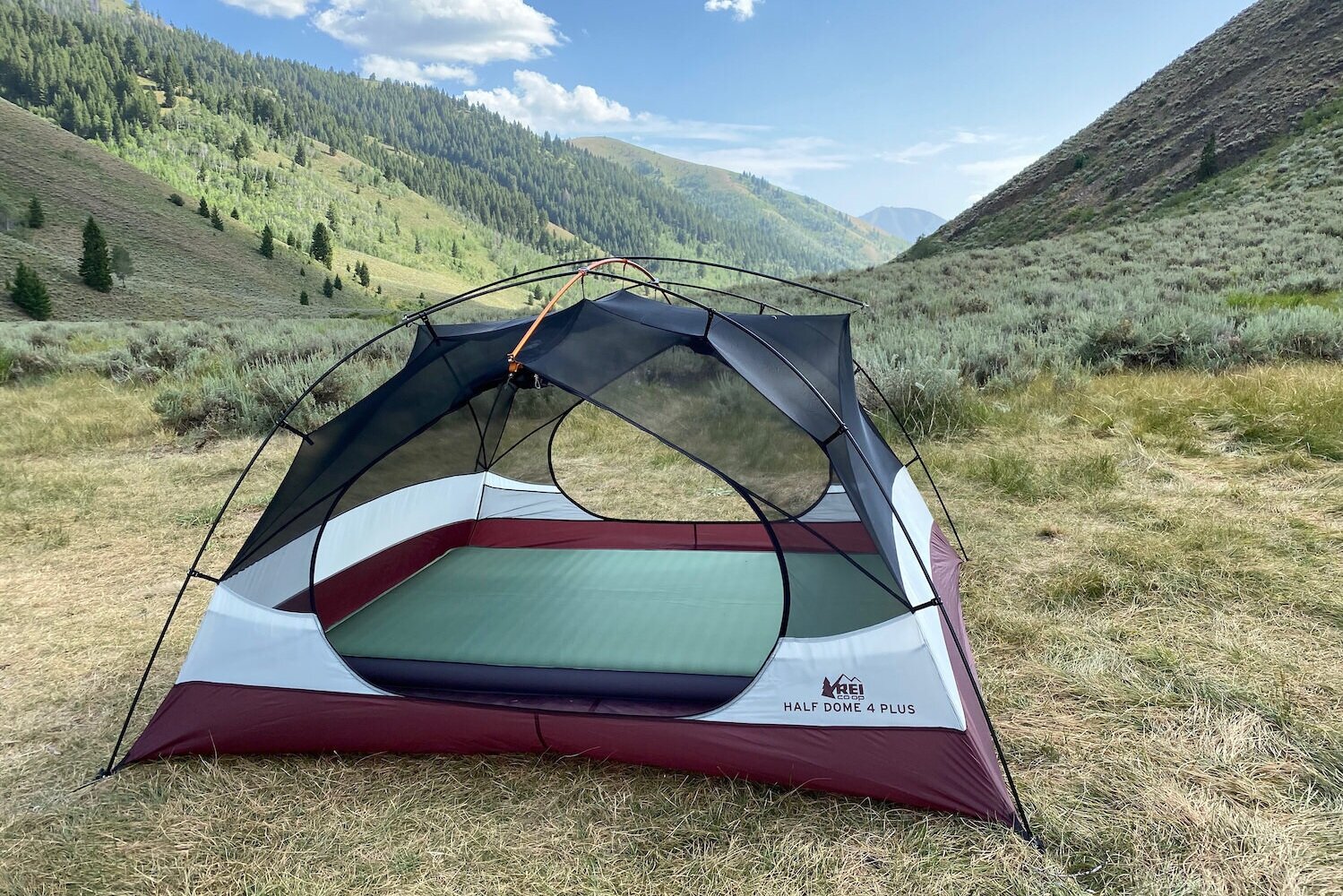
NUMBER OF DOORS
We think multiple doors is a must for group camping. The freedom to enter, exit, and access gear in the vestibules without disturbing your camping crew makes overnight adventures far more enjoyable. Adequate doorway and vestibule space are essential when it’s rainy and everyone wants to clamber into the tent to get out of their wet or dirty clothes as quickly as possible.
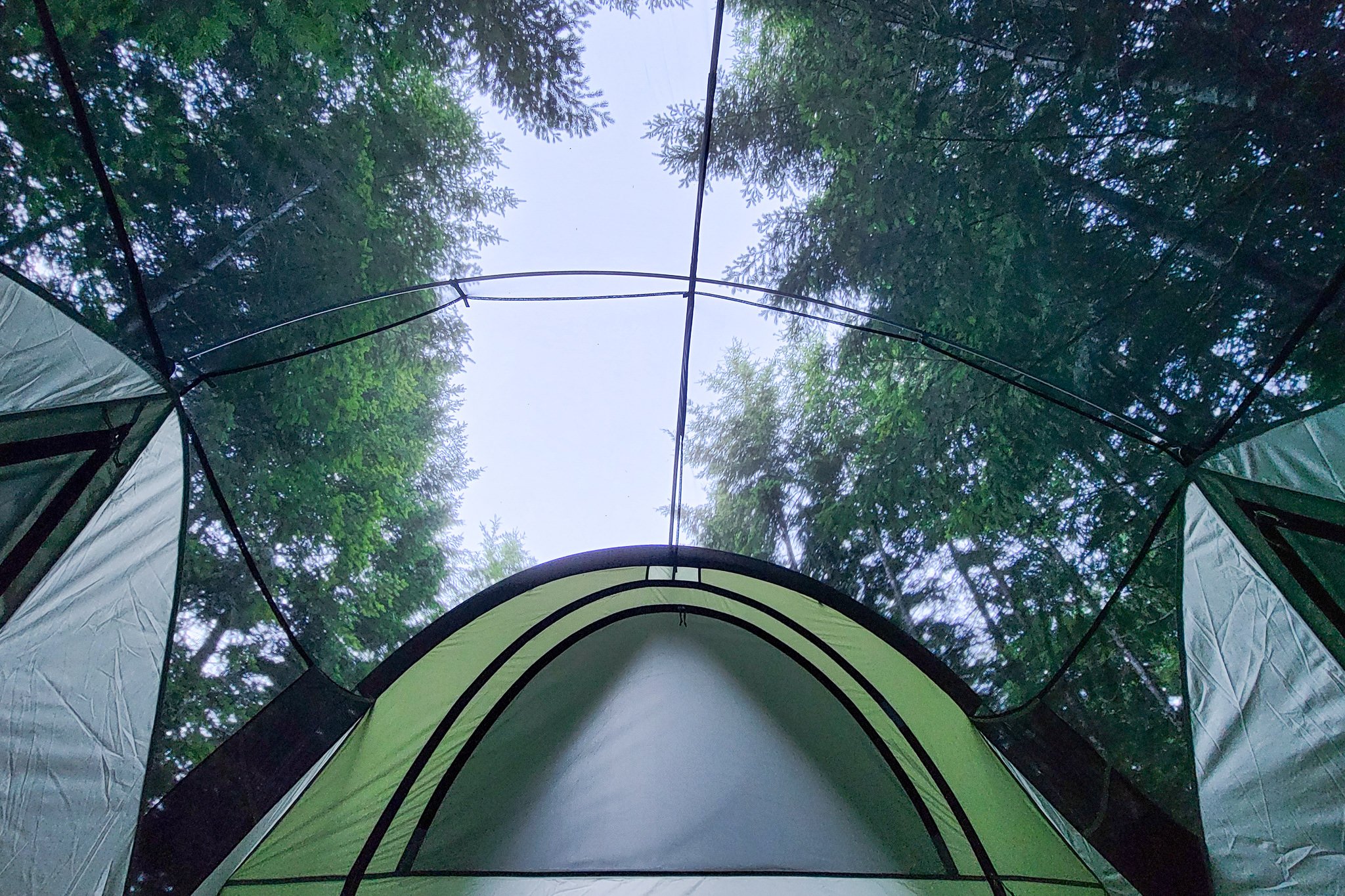
VENTILATION
Good ventilation is important for controlling internal condensation. Look for tents designed with adequate roof vents that allow fresh air to circulate, rain or shine. It’s not much fun being cooped up in a muggy tent without functional vents when the weather turns foul or the temperatures fluctuate. Some tents have zippers that allow you to access top vents with kickstands from the interior of the tent, which comes in handy when high roofs are hard to reach on the outside. Be sure to stake out the sides of your rainfly for better air circulation.
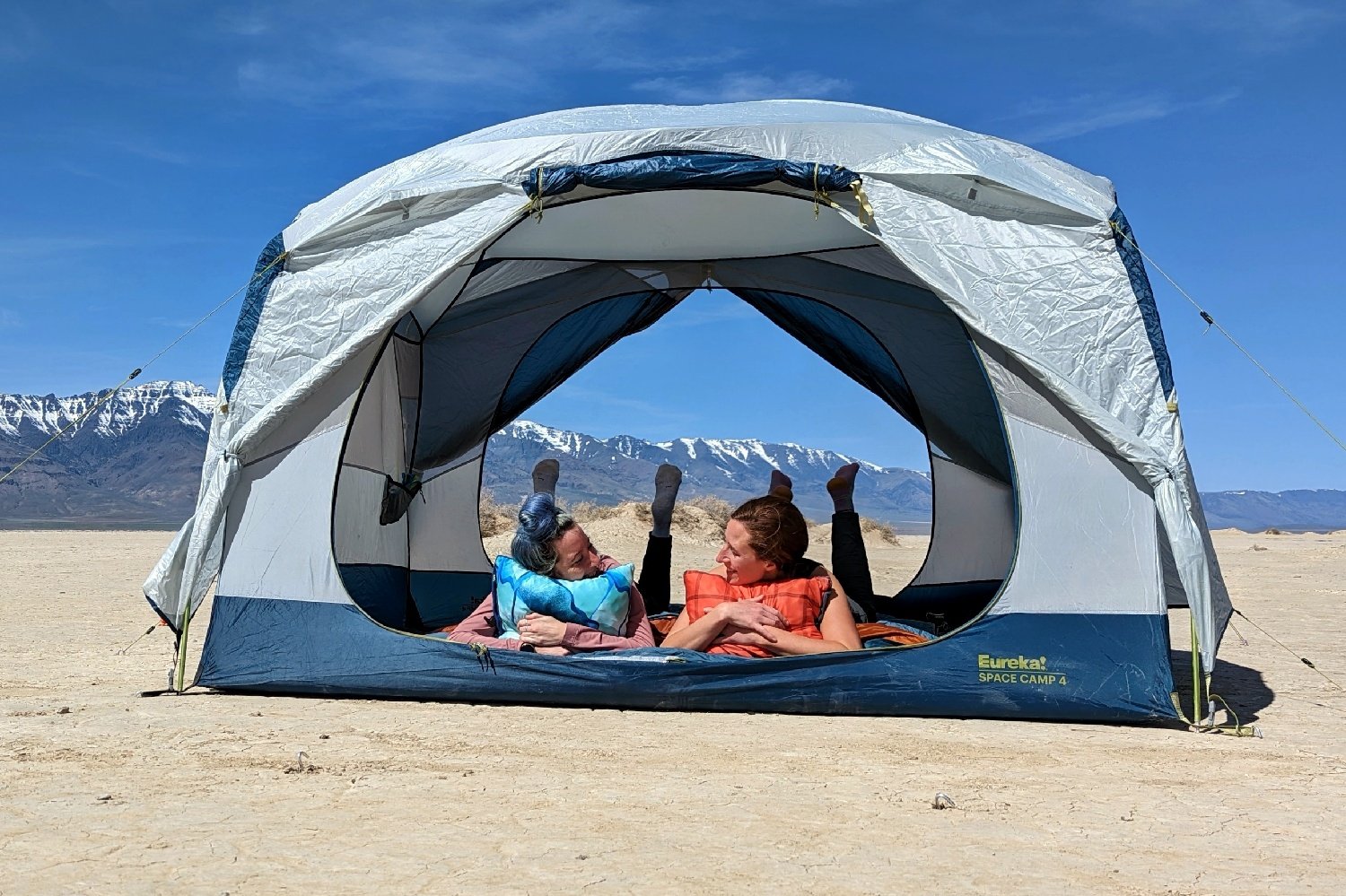
EASE OF SETUP
Setting up any tent for the first time can be a challenge, but it always gets easier with practice. Many tents are designed to be intuitive and quick to pitch with color-coding poles, buckle clips, and simple, user-friendly directions. Be sure to choose a tent that’s a manageable size and weight for you to handle easily, especially if you’ll be pitching it alone. Large tents can be awesome, but don’t choose one that’s so complex that it takes all the fun out of camping, or requires multiple hands to pitch.
WATERPROOFING
Most high-quality tents come fully seam-sealed to prevent water from penetrating where the fabric has been stitched. If the instructions tell you to seal all the seams to increase weather protection, that means the tent isn’t storm-proof – yet.Seam sealing isn’t difficult, but it can be time-consuming and somewhat tedious, especially on a large tent. If your tent was once seam-taped, but you’ve noticed it starting to leak, it might be time to do some maintenance to extend the life of the tent by waterproofing it properly, including sealing the seams, replacing a peeling polyurethane coating, and refreshing the DWR coating on the rainfly.
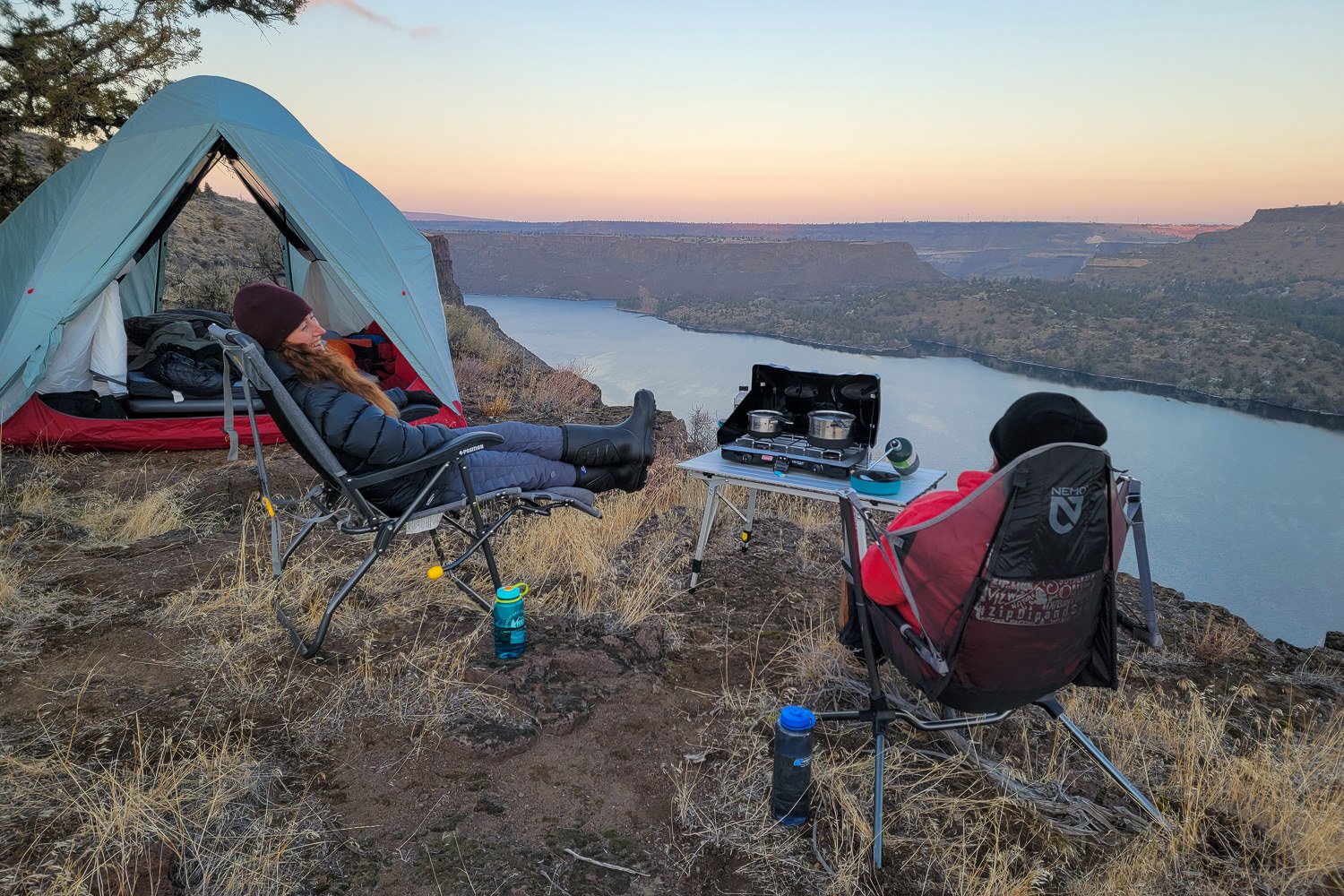
VESTIBULES & AWNINGS
Vestibules are covered areas outside your tent doors meant for protecting and storing gear like backpacks and shoes – so you keep the bulk and mess outside of your sleeping area. If you plan to camp in places where it rains often, make sure your tent has one or more big vestibules so you won’t have to bring wet or muddy gear inside your sleeping area. Some vestibules can also be converted into awnings for shade using pole accessories (not included). Other campers bring a separate shade or screen house that can be set up away from their tent, while others prefer to use an awning directly attached to their tent like a porch.
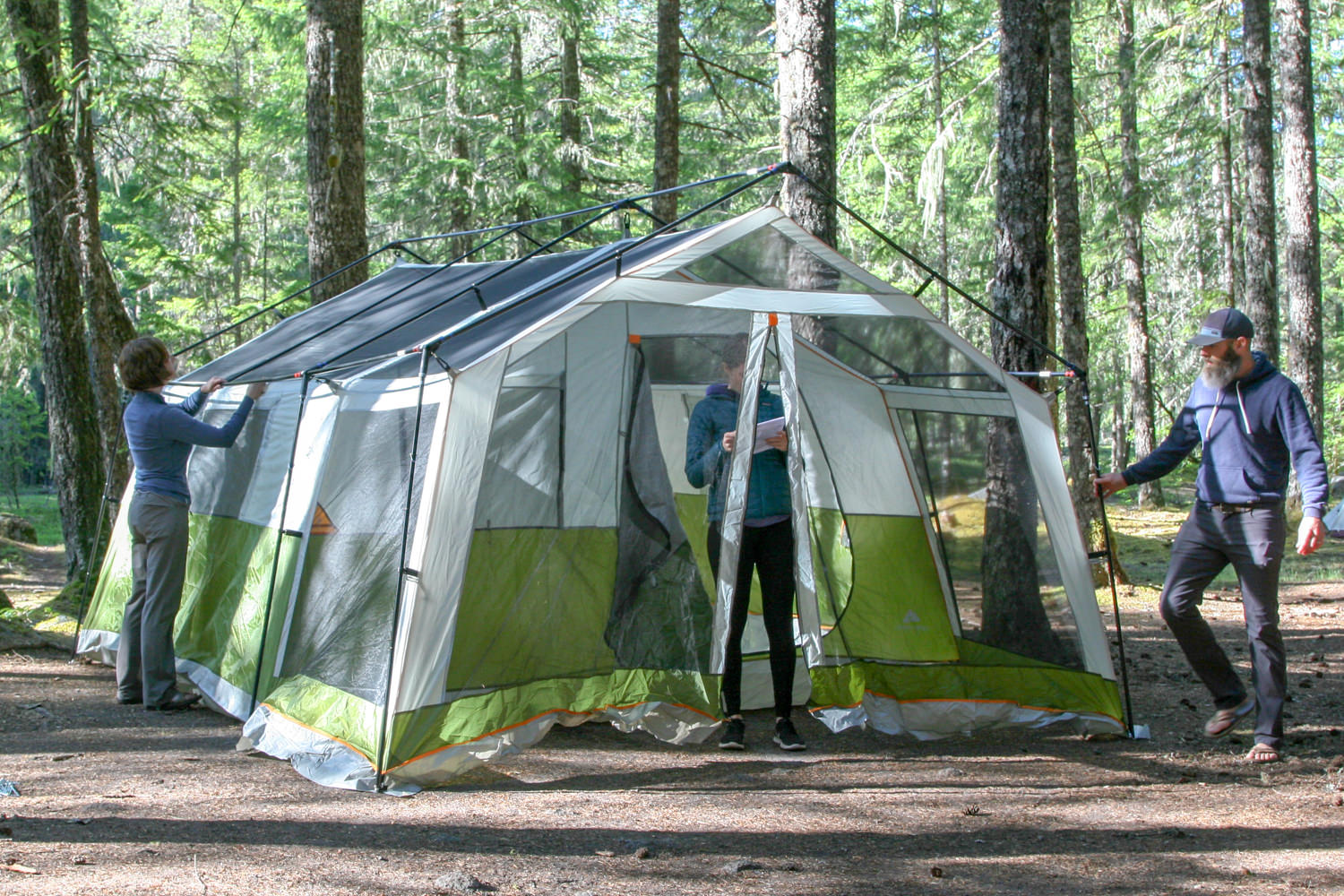
PACKED SIZE
The packed size of your tent is vital for backpacking, but it’s not as important for car camping. Still, it’s smart to consider how much space you’ll have for your gear in your car and at home. A compact tent will be far less cumbersome to maneuver.
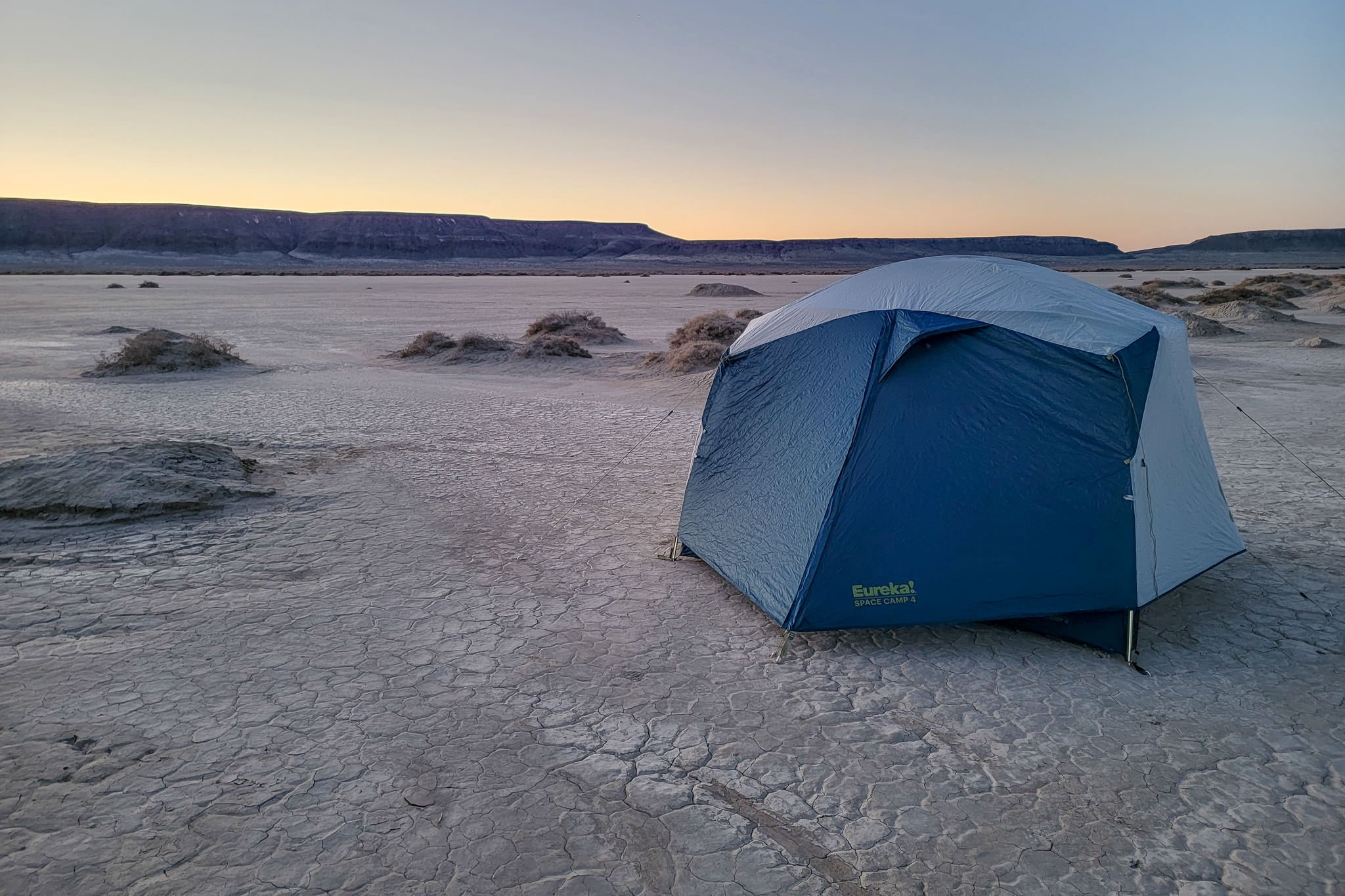
SEASON RATINGS
3-Season Tents
3-Season tents are the most common type of tent and are typically meant to be used during the summer months when the weather is fair. These tents tend to have good ventilation and will protect you from rain and insects, but they may not be robust enough to withstand intense storms with heavy rain or high winds.
3-4 Season Tents
Some 3-season tents can be used from early spring through late fall, where the signs of winter are still obvious. They’re designed with more weather protection in mind and seek to offer a balance of ventilation, strength, and heat retention. These tents are often dome-shaped to shed rain and light snow with slightly more robust poles to give the structure rigidity to withstand winds. The rain fly will usually be more full-coverage and extend almost to the ground with one or more vestibules to keep gear and shoes dry.
4-Season Tents
4-season tents are best for those who plan to camp in snow and inclement weather, but they’re overkill for most 3-season car campers since they’re generally much more heavy and bulky. They tend to have lower-profiles and are dome-shaped to shed snow and high winds. The biggest downside of 4-season tents is they have much less ventilation, which can make the living area too warm and stuffy in warm conditions. Save the 4-season tents for winter camping or extended trips in heavy rains when it’s critical to have a warm, safe shelter.
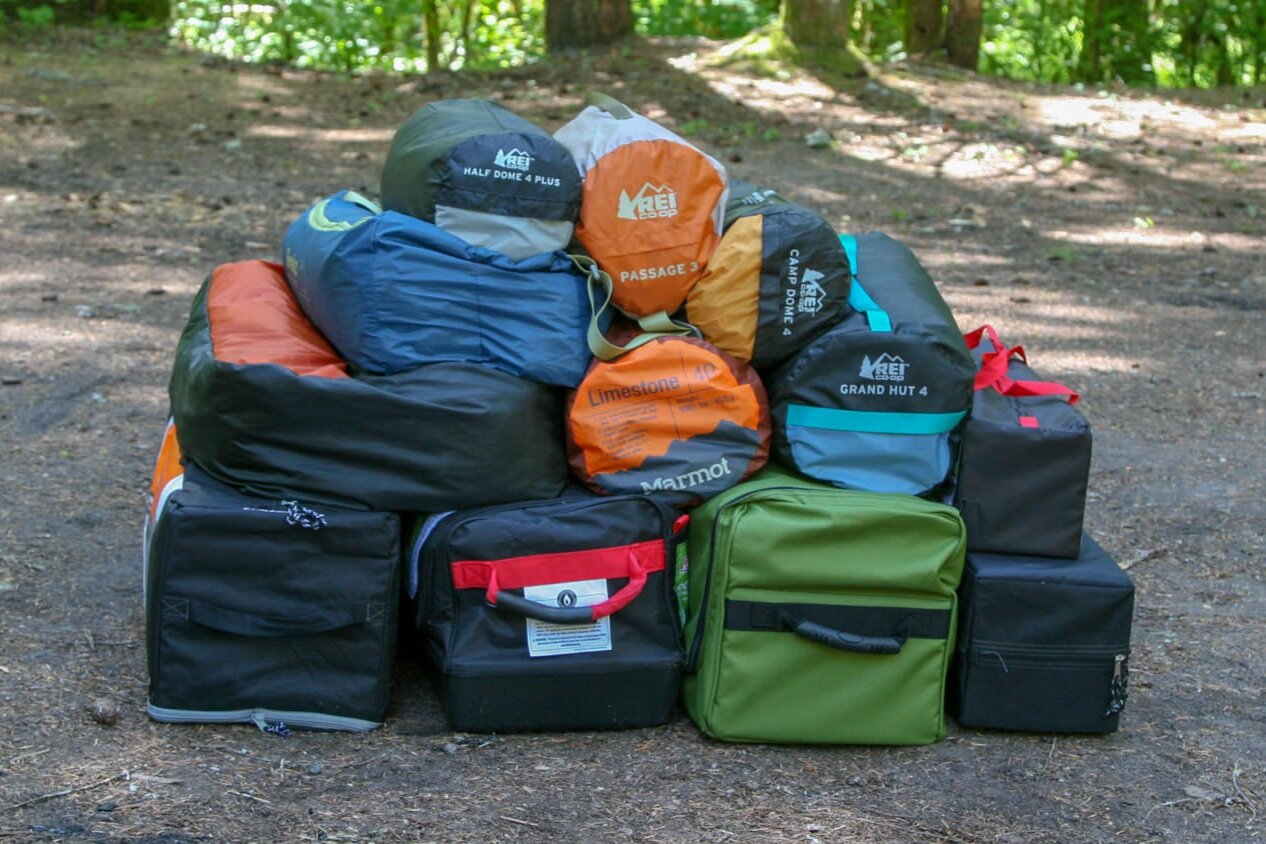
PACKAGED WEIGHT VS. MINIMUM TRAIL WEIGHT
Different websites list different specs for tent weight, and it can be confusing if you’re unsure of the terminology. Unfortunately, there’s no set standard for measuring the weight of tents across the industry – so your confusion is warranted – but we’ve got a few tips to help you navigate measurements:
Packaged Weight – This is the number we use to measure total tent weight in this guide. Packaged weight represents the weight of all parts of your tent plus included accessories at the time of purchase. This is the most accurate measurement since it includes everything you’ll need to pitch your tent.
Minimum Trail Weight – This spec represents the minimum components you’ll need to stay dry in a storm. It usually includes the tent body, rainfly, and poles, but depends on the tent model and what the manufacturer deems “minimum” or “necessary”, so this measurement is less reliable than Packaged Weight. This spec leaves out the weight of the stuff sacks, guy lines, and tent stakes (unless your tent is semi-freestanding).
FOOTPRINT
If you’re spending a significant amount of money to buy a quality tent, it’s well worth investing in a footprint to extend the life of the fabric. The footprint is a lightweight material that adds just a bit of extra material to increase the durability of your tent floor and add a bit of an extra buffer between your home in the woods and poky branches, sharp rocks, or rogue thorns. If a specific footprint isn’t available for your tent model, a generic one will do. Just make sure the footprint you get is the right size – a footprint that’s too large can collect water and cause it to pool under your tent, and a footprint that’s too small won’t provide adequate coverage. Check out our post Do You Really Need a Footprint? for more information.
STAKES & GUYLINES
Fully staking out a tent maximizes interior space and makes the tent more sturdy. Taking a few extra minutes to completely stake down and guy-out your tent could mean the difference between your tent lasting for years, or rolling away in the wind and ripping to shreds. If your guylines didn’t come pre-attached, the best way to attach them to the rainfly is with a bowline knot.
If your tent has a lot of guy lines and stake-out points, consider bringing a small mallet to make the staking process quicker and easier. Many camping tents don’t come with enough stakes and guylines for all of the guy-out points, so it’s a good idea to pick up some extra guy lines and tent stakes at the time of purchase or immediately afterward.
Honorable Mentions
These camping tents have a lot of good things going for them and one of them might be just right for you and your family:
This tent is an excellent family option that boasts a ton of interior space. We love the easy setup, the large vestibule with a door that rolls completely out of the way, and the smart pocket locations. Thanks to clever vent placement and airy fabrics, the Base Camp is great at condensation management and feels cool and airy on even the warmest days.
The affordable option is a stellar budget tent for individuals or couples who want a practical camping tent that’s easy to pitch. The Trail Hut is very affordable but has some of the same features as more expensive tents like two wide doors, double vestibules, and good vents. It’s lightweight and compact enough that it could be used for backpacking trips.
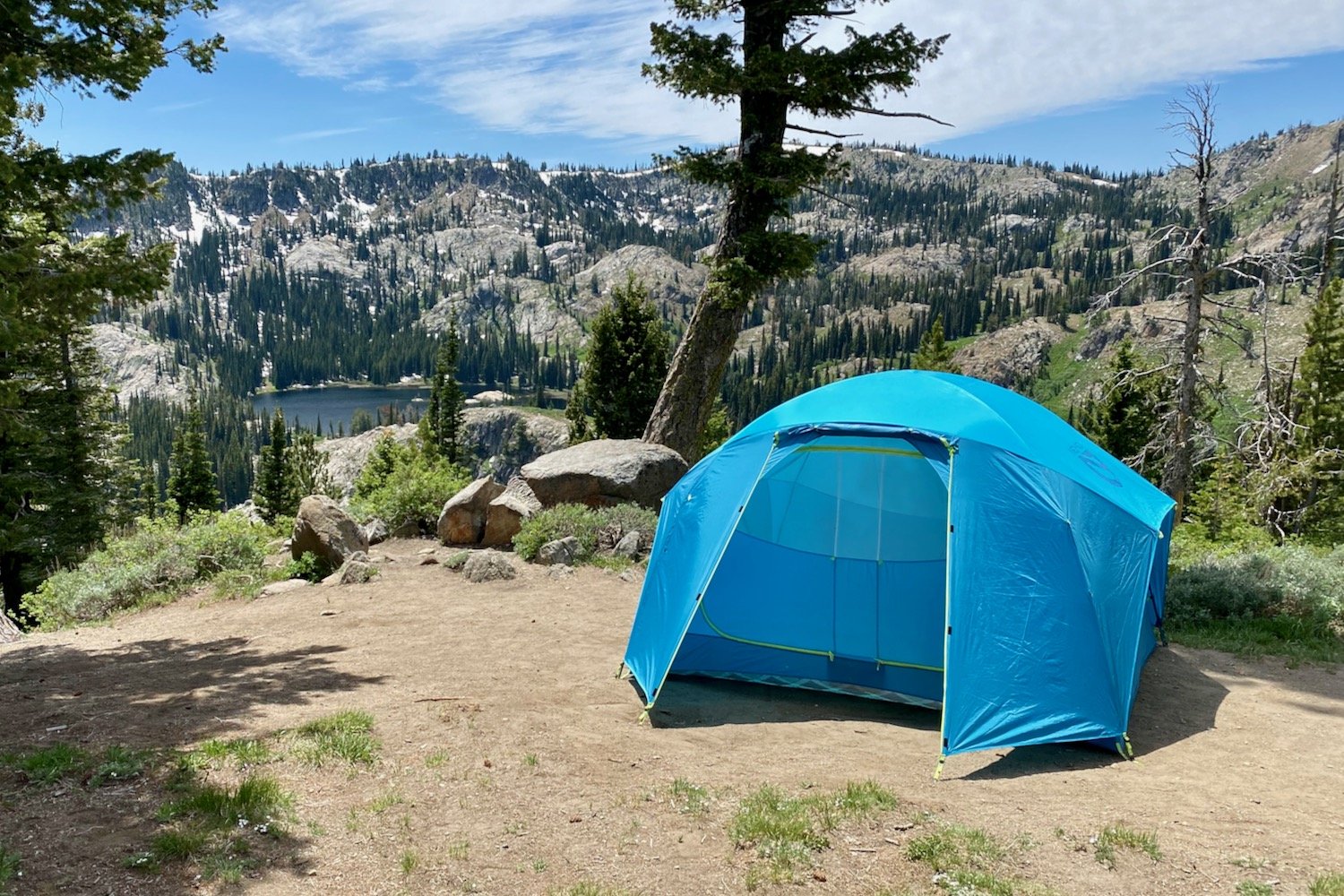
Conclusion
Choosing the right tent is crucial for a comfortable and enjoyable time camping, and having. With so many options on the market, finding the right blend of features, space, weather resistance, size, and ease of setup is no small task, but we hope this guide helps you find the perfect option for your next adventure. Happy trails!


